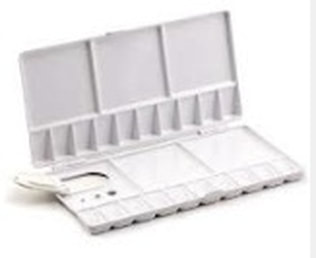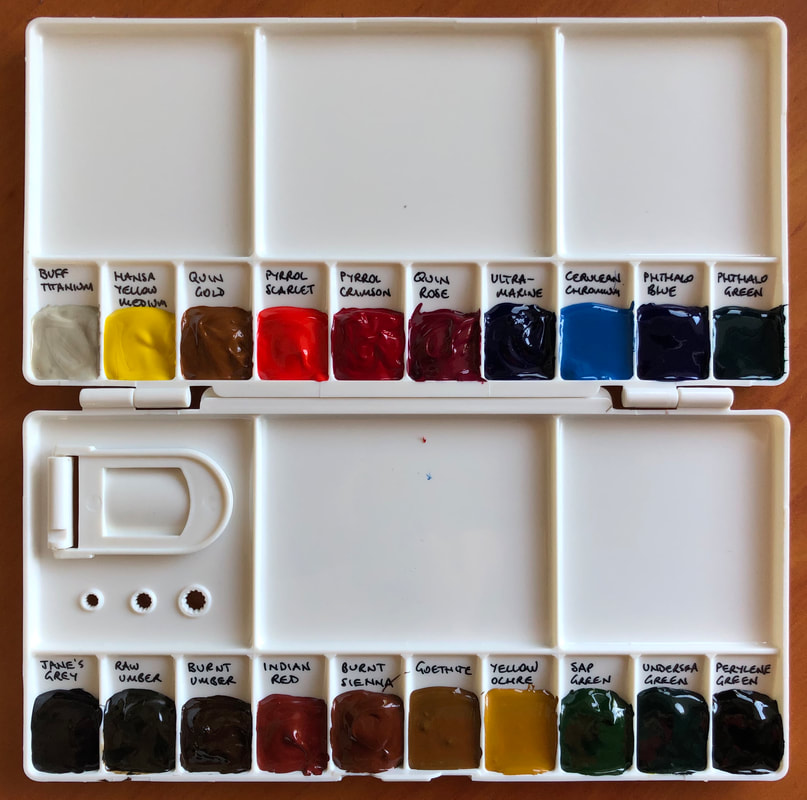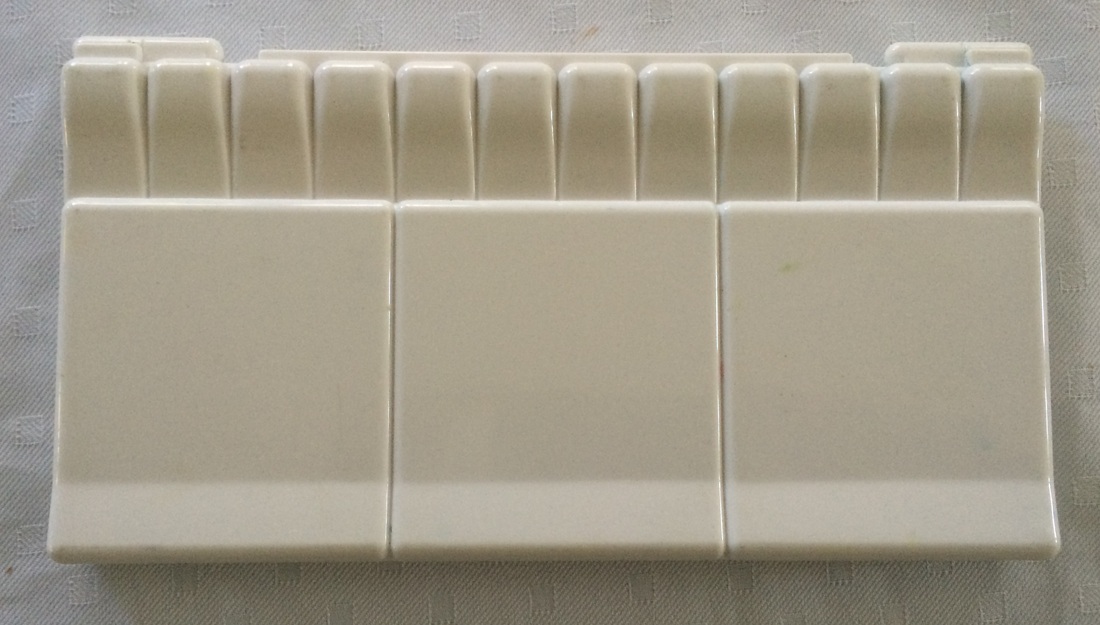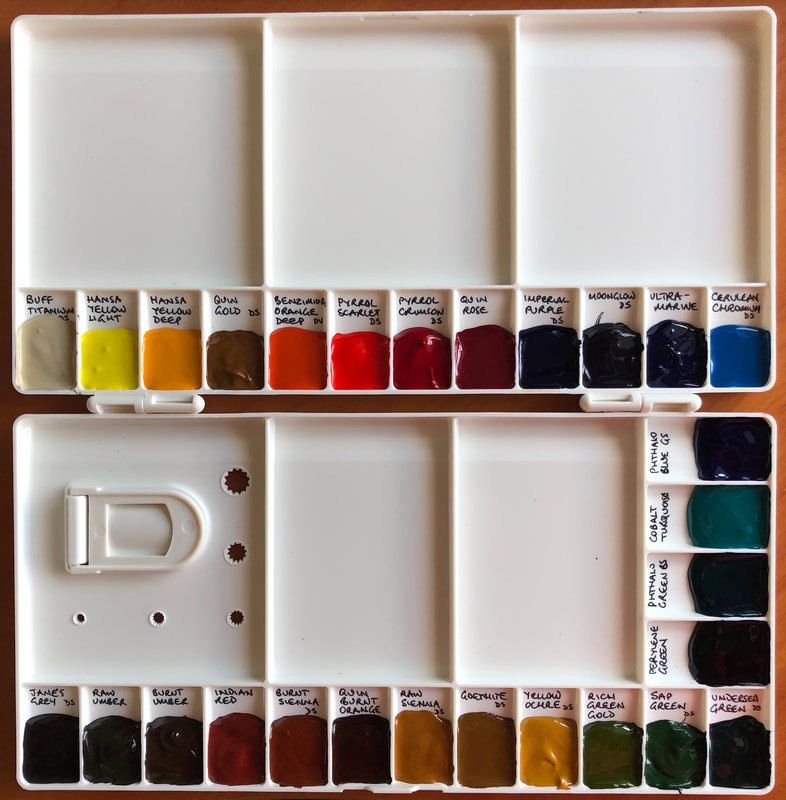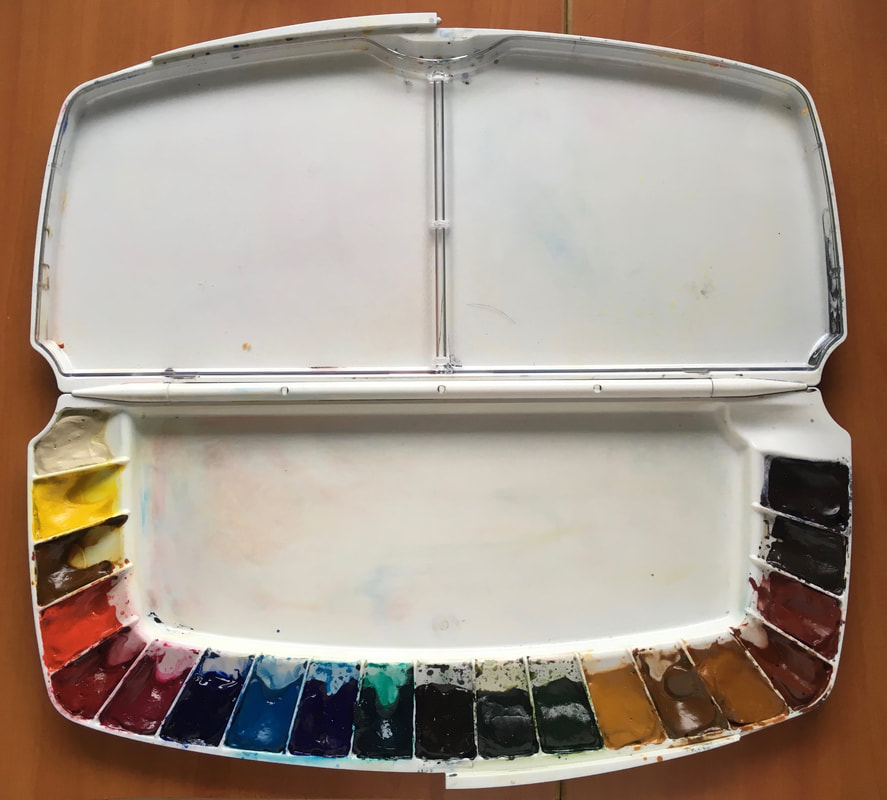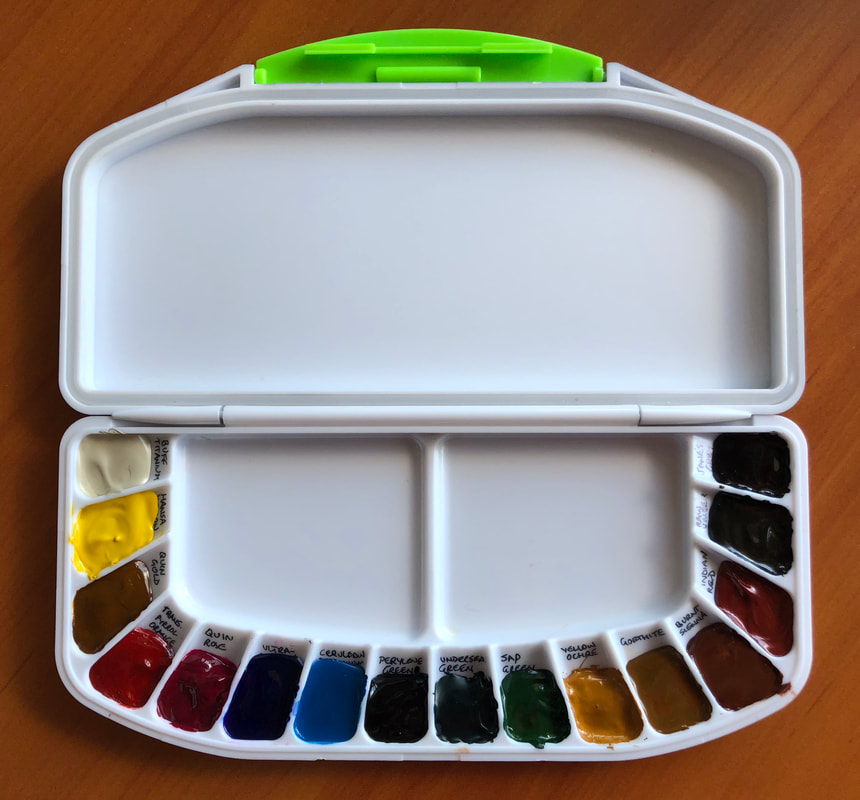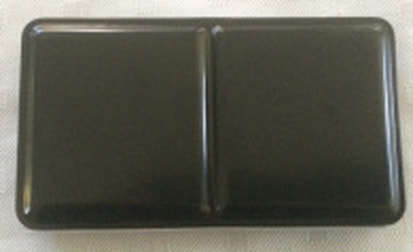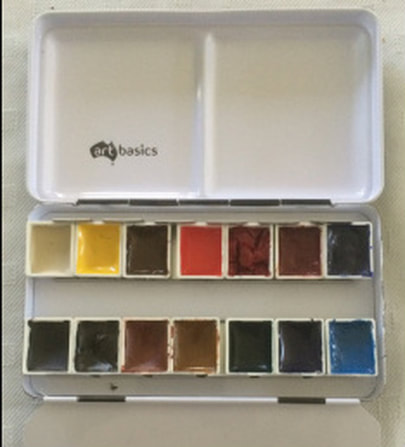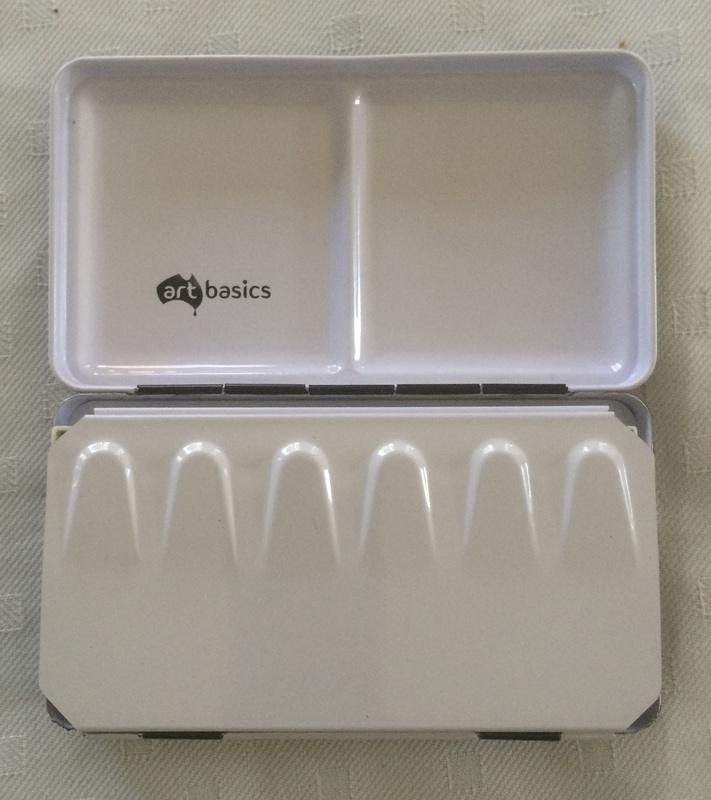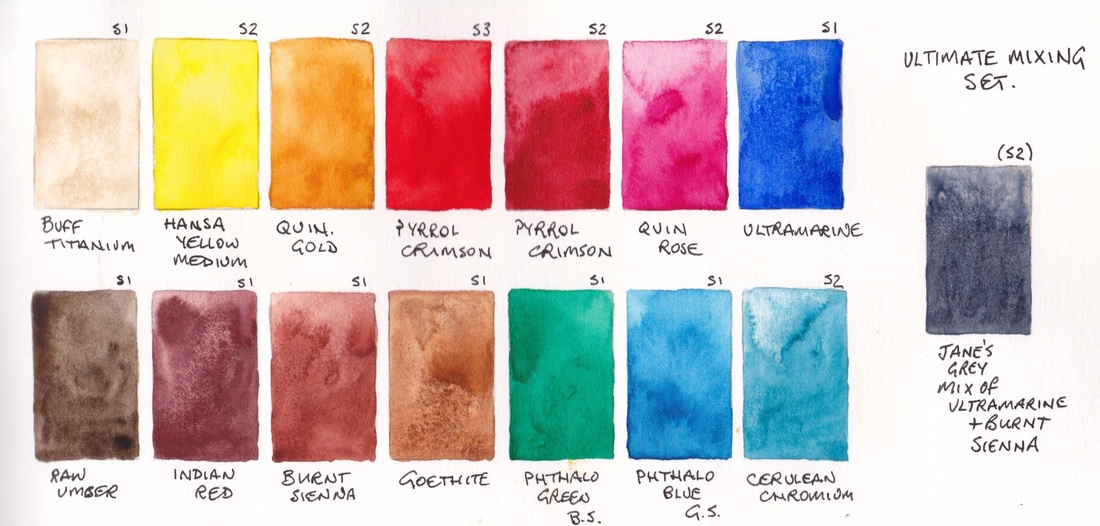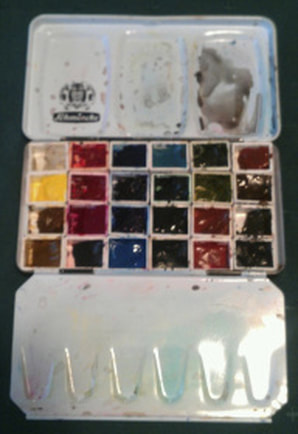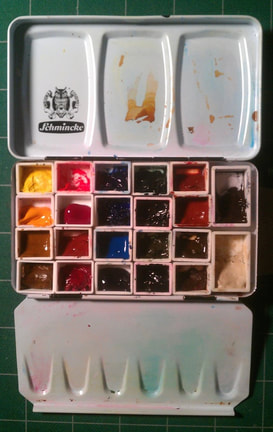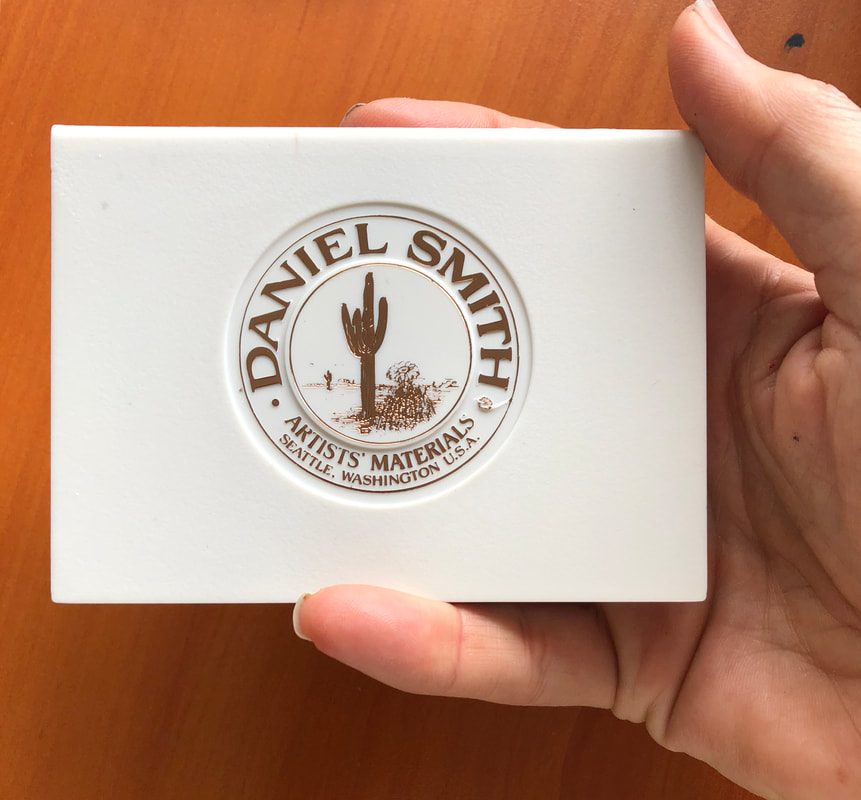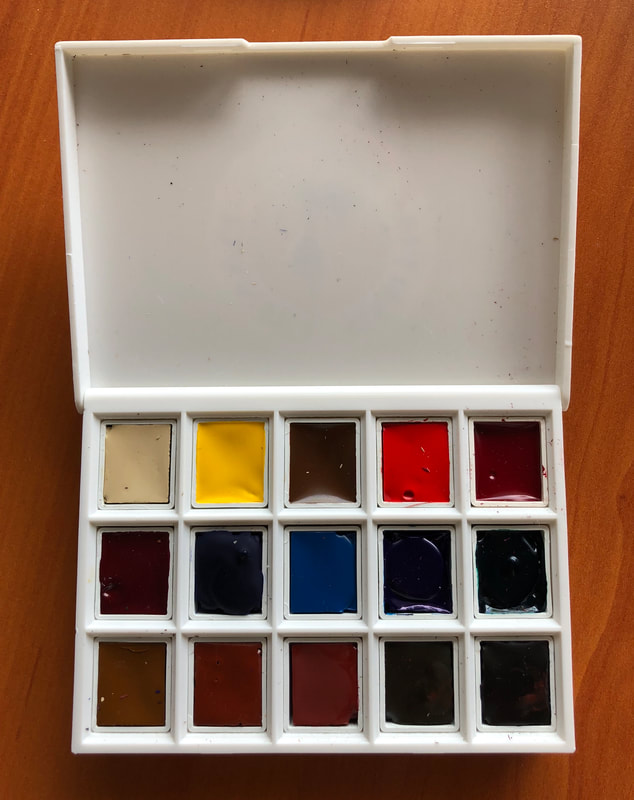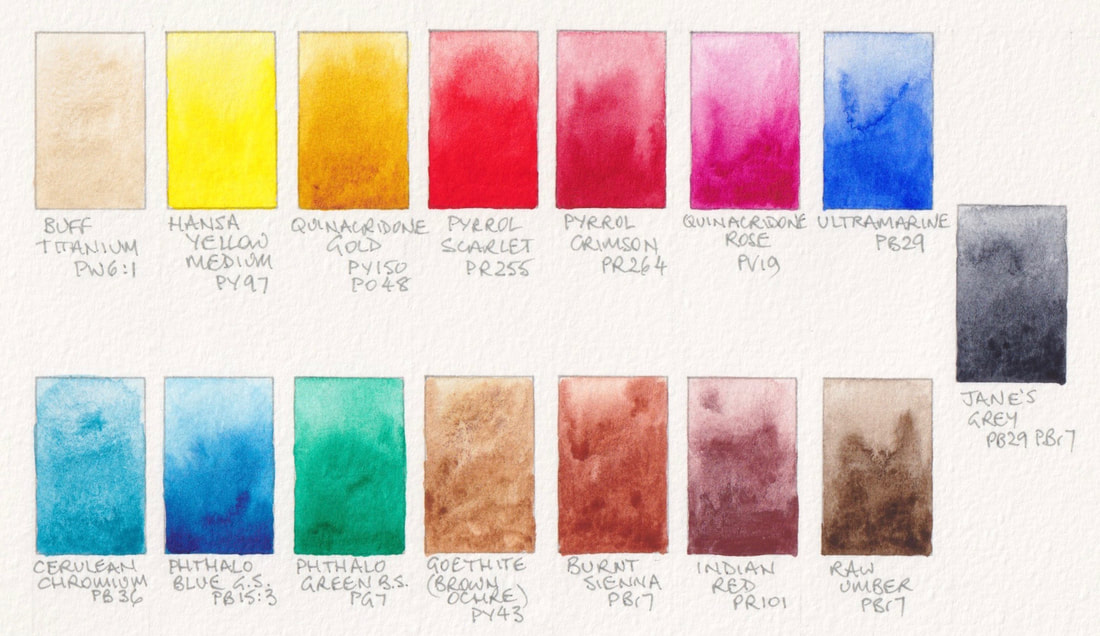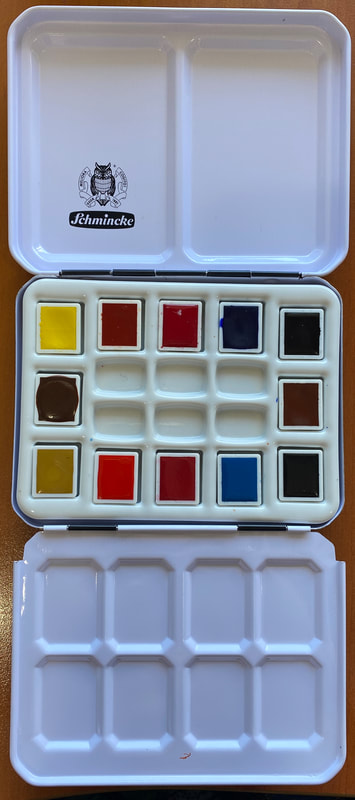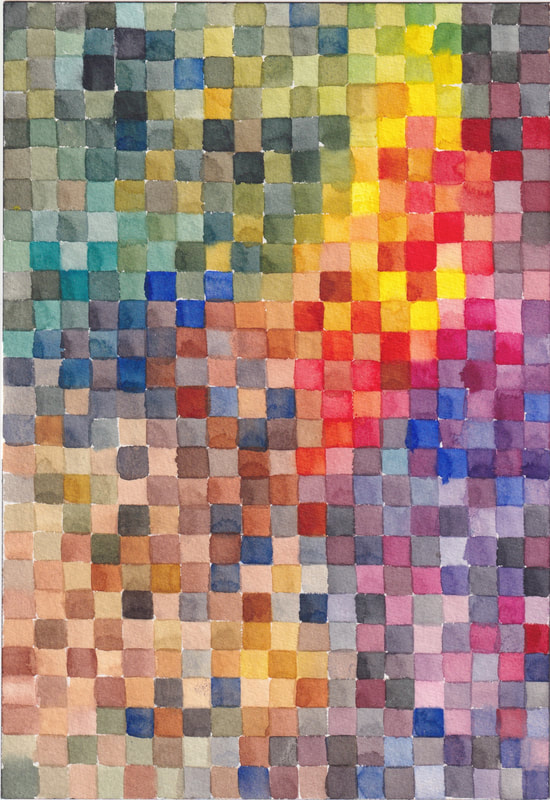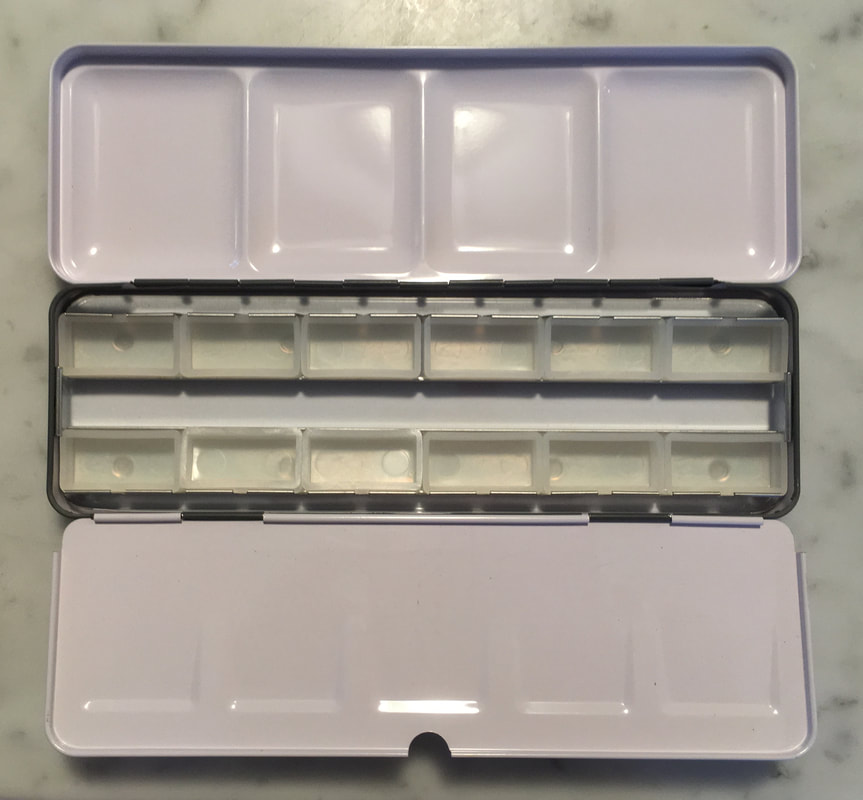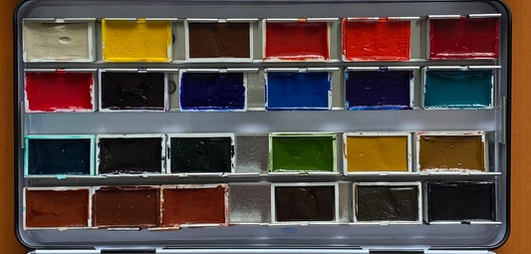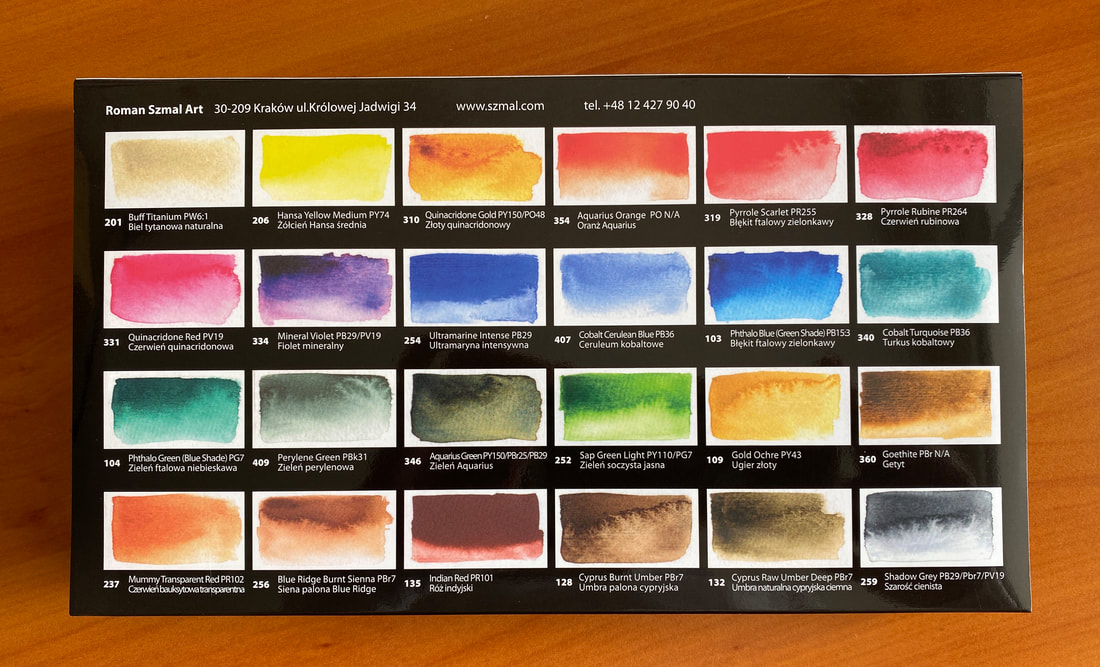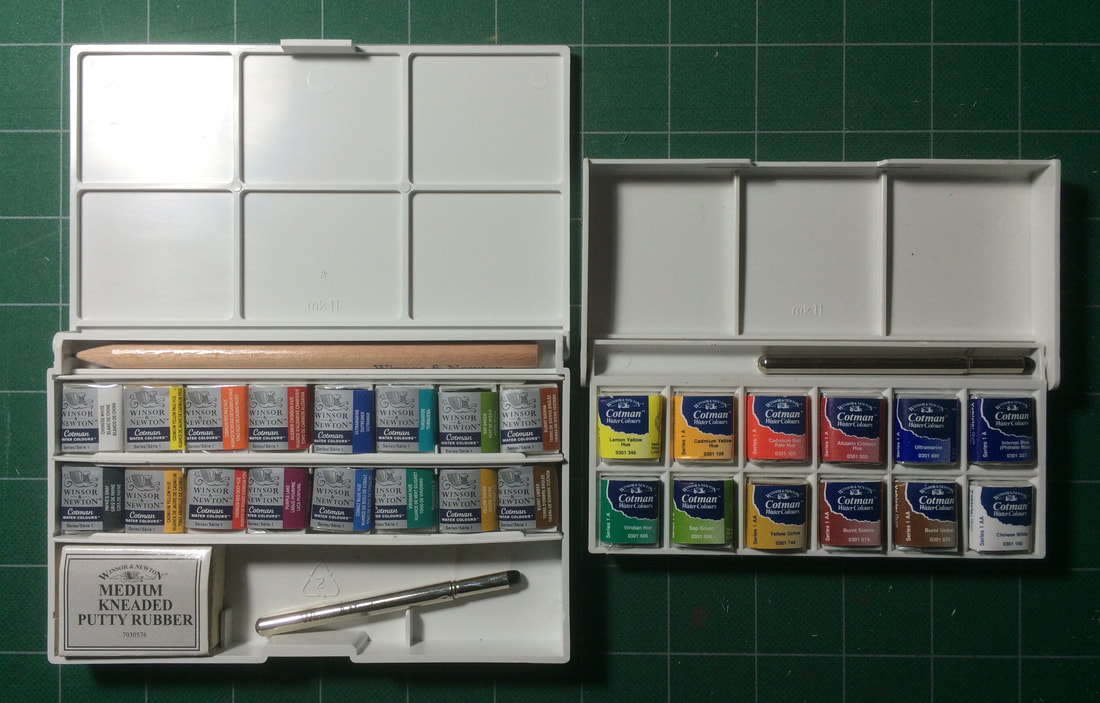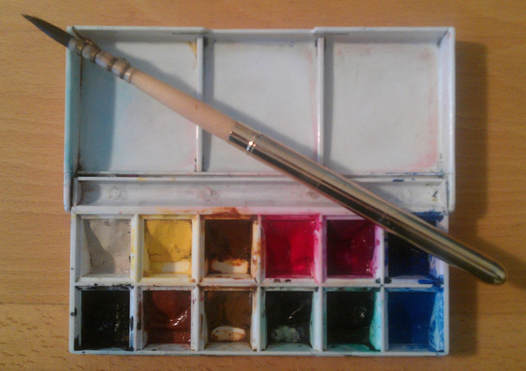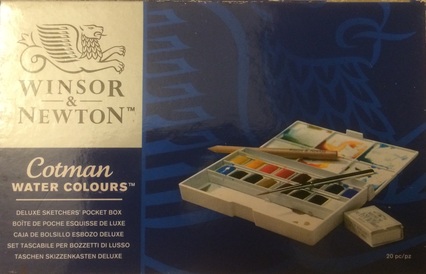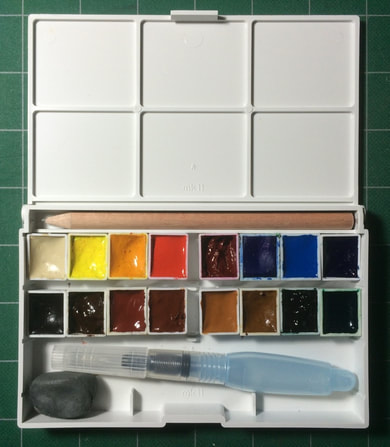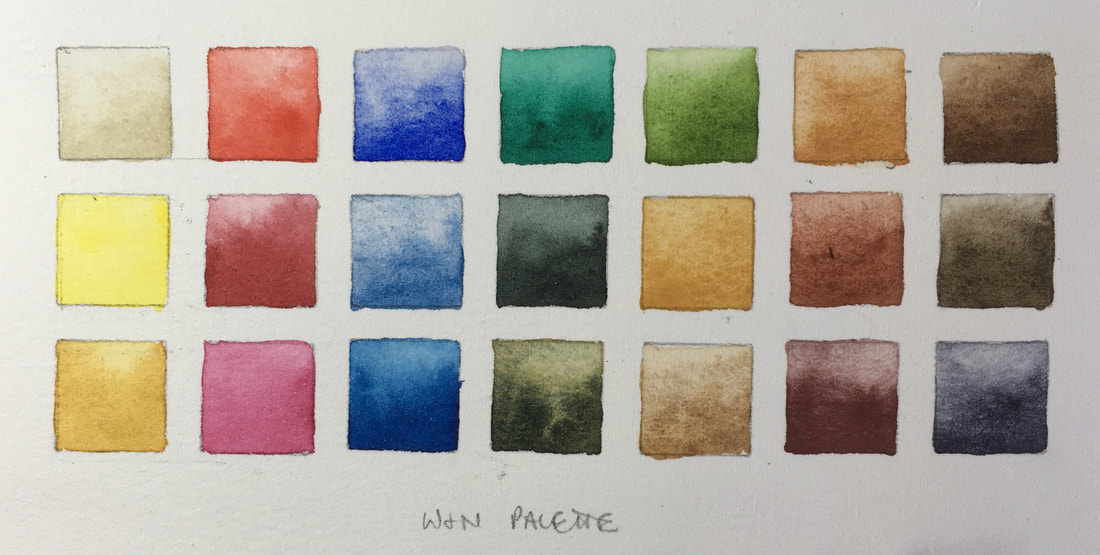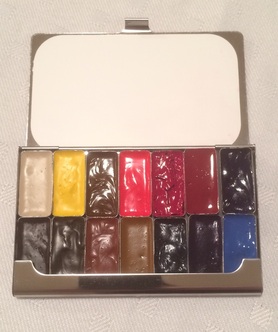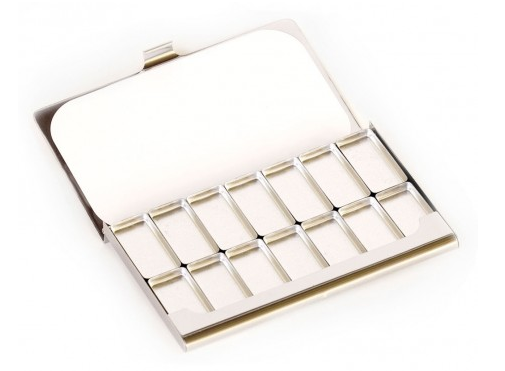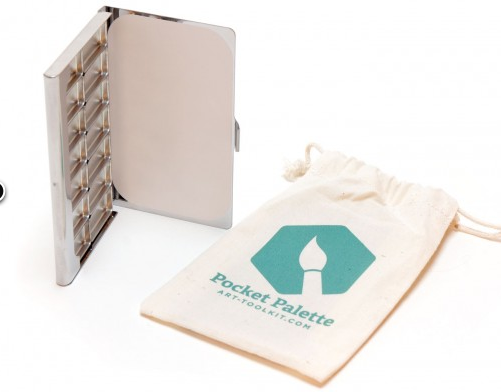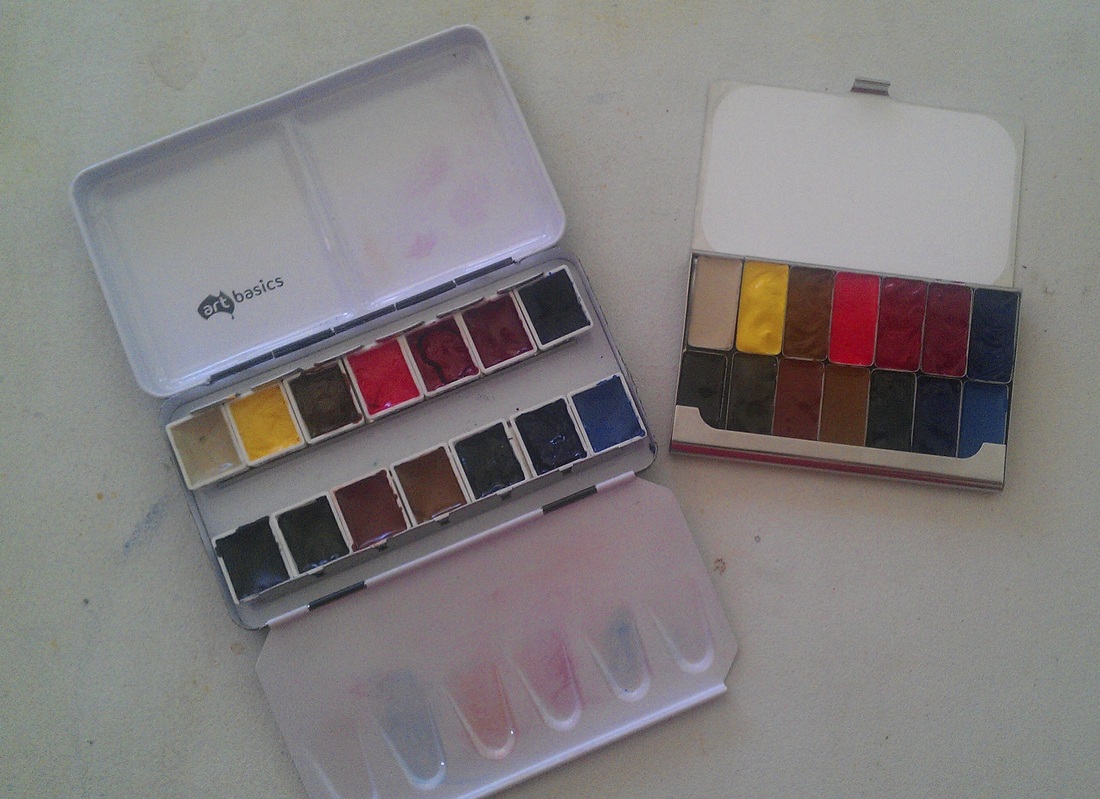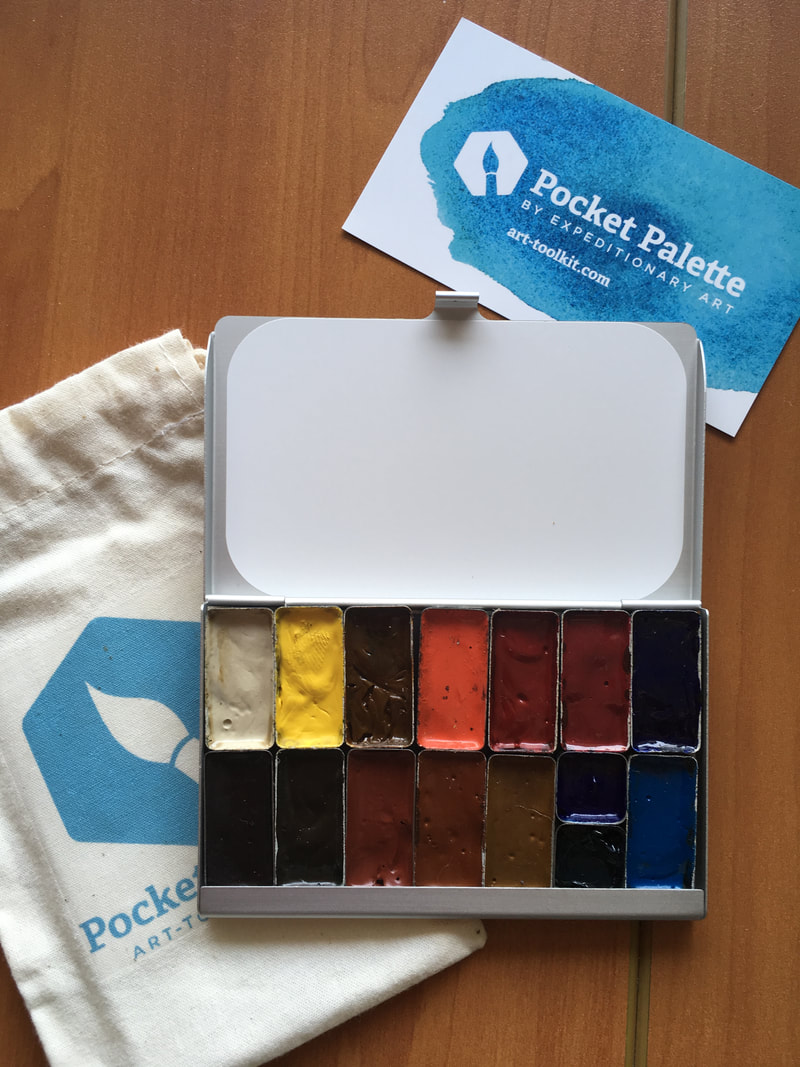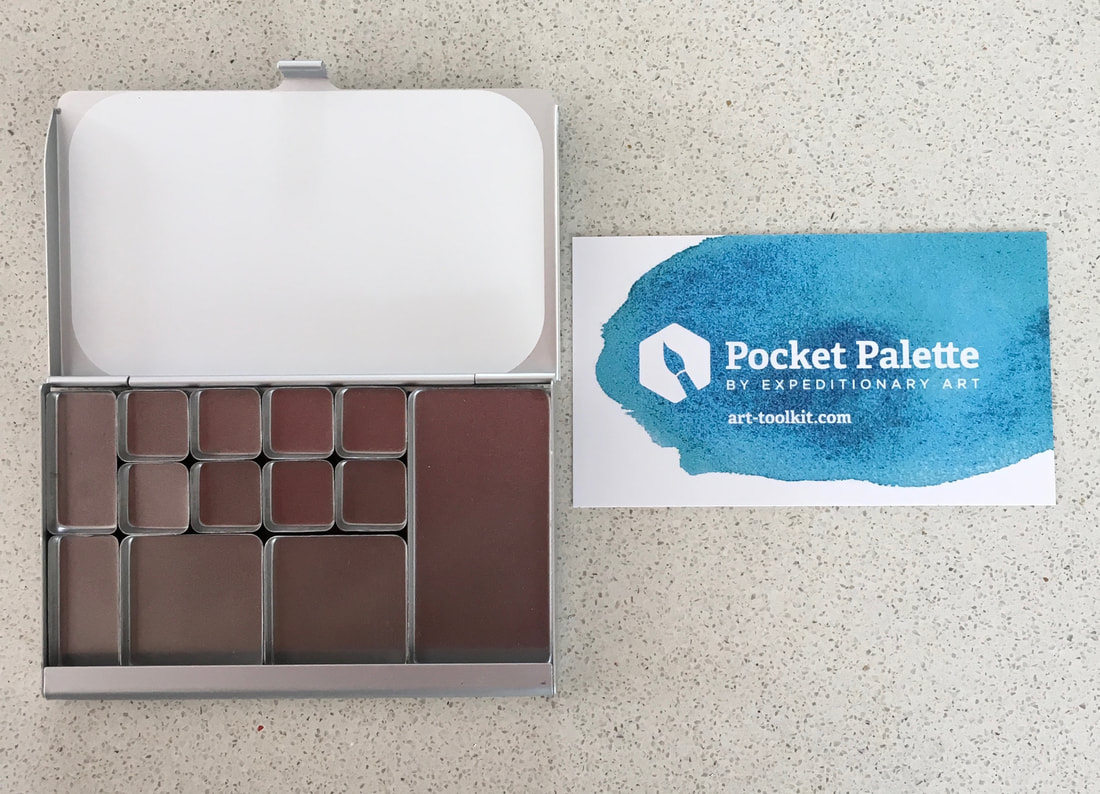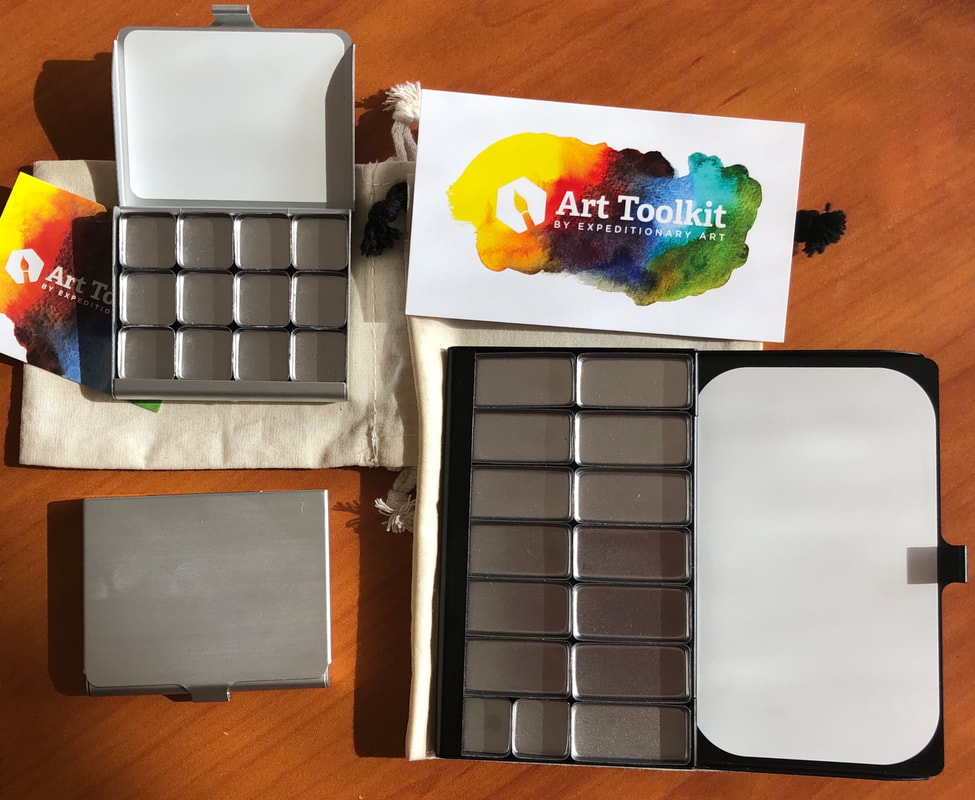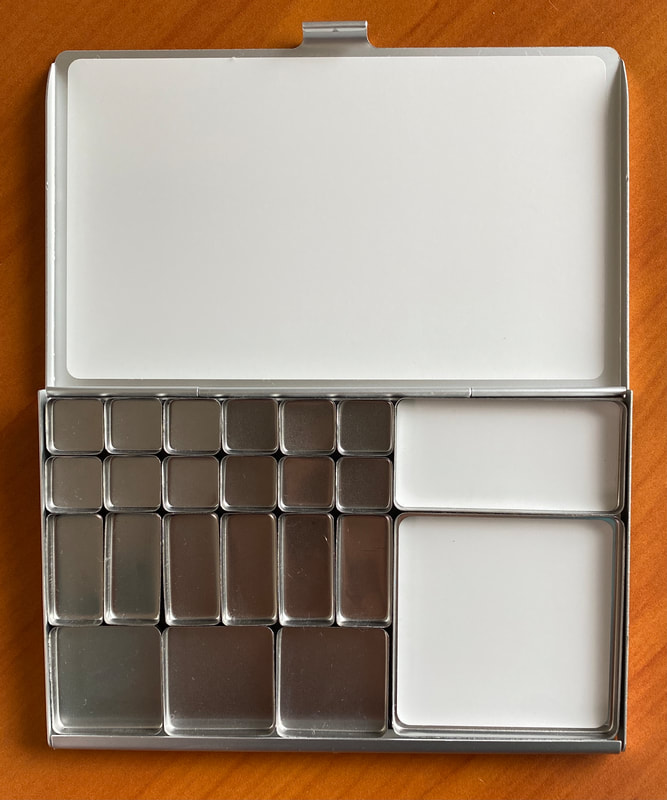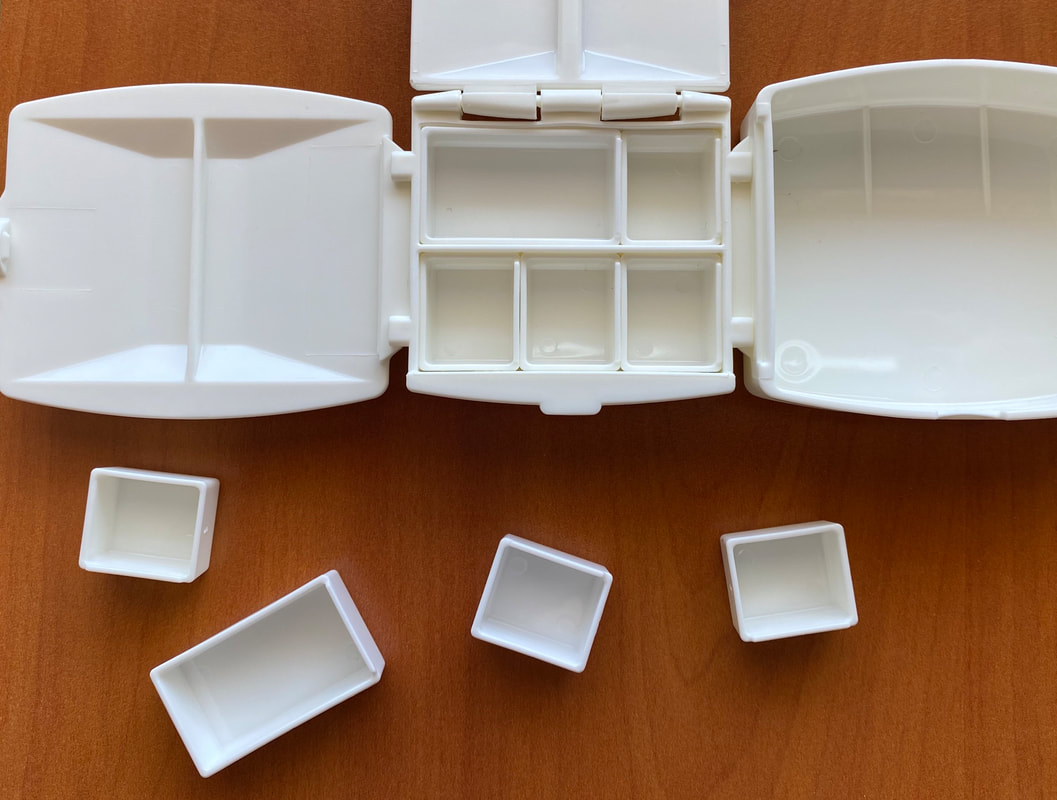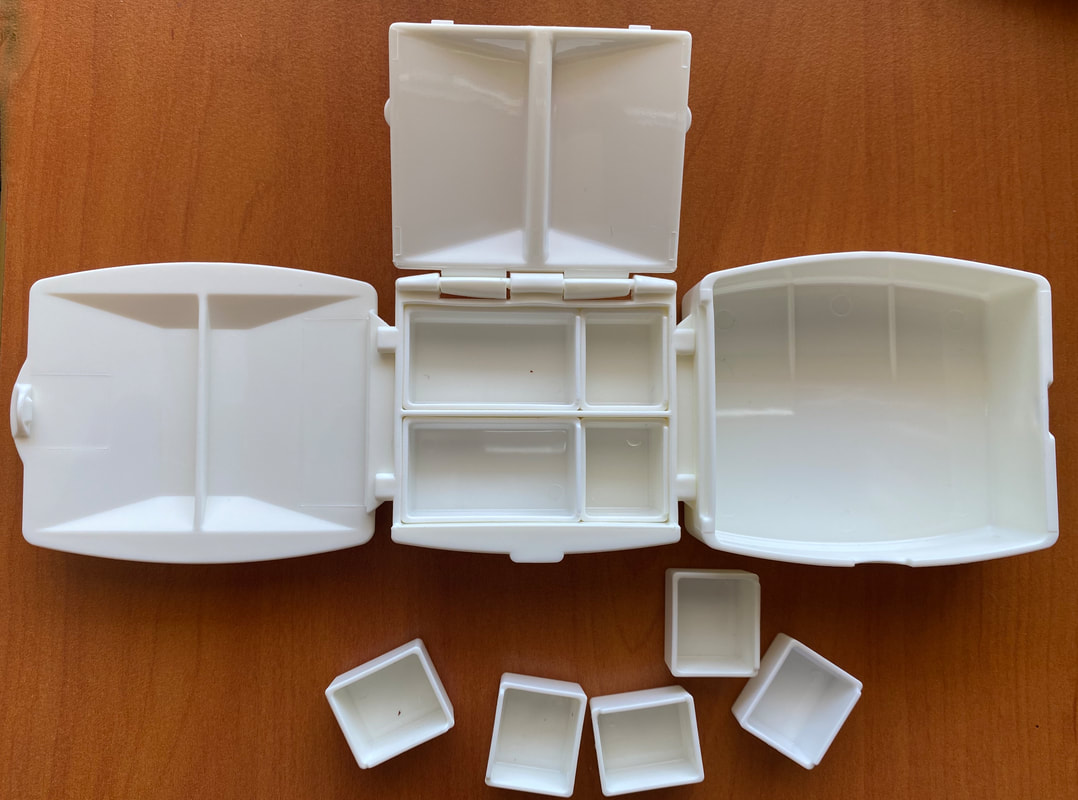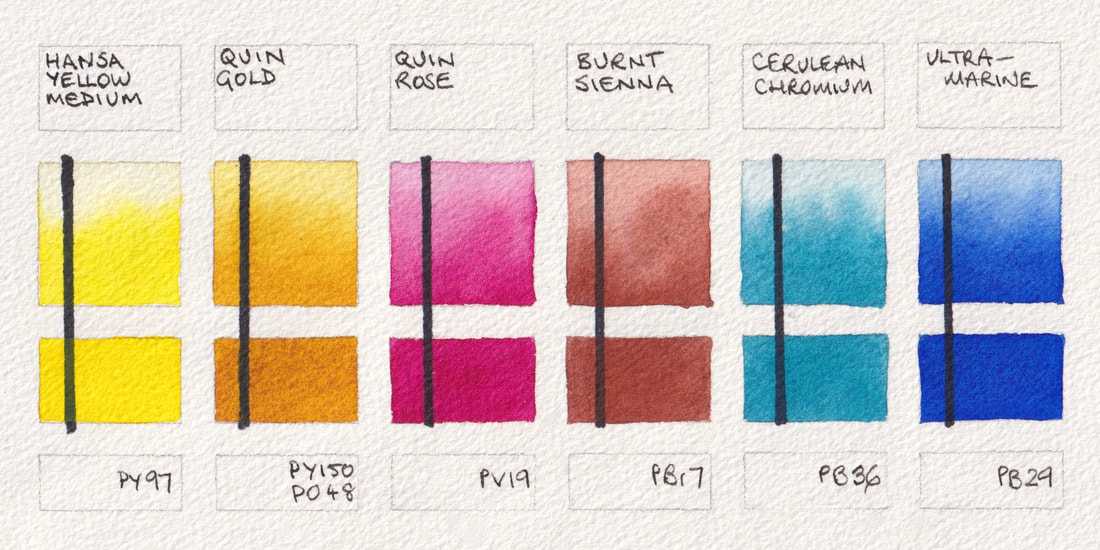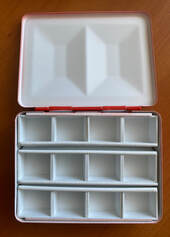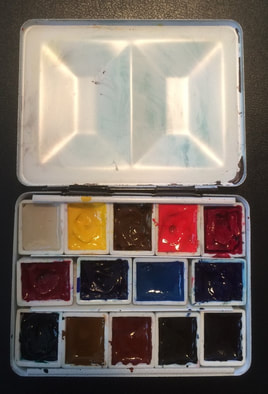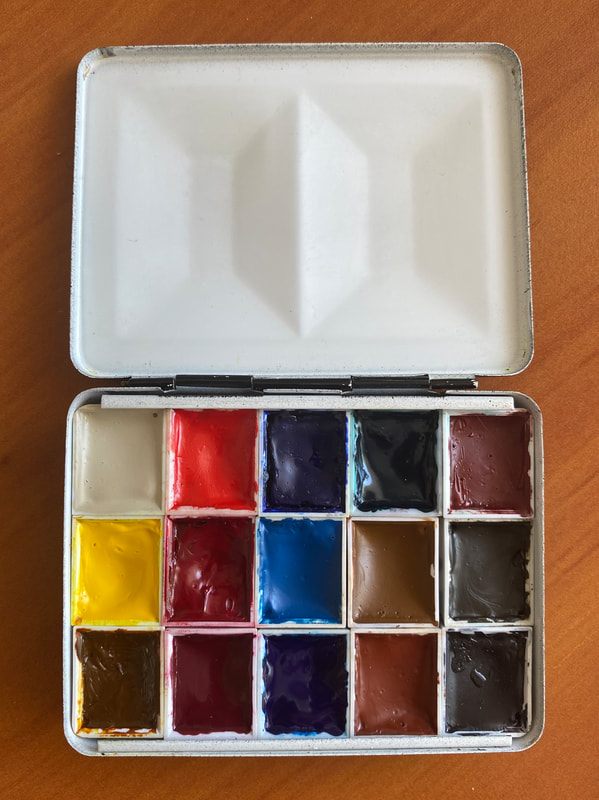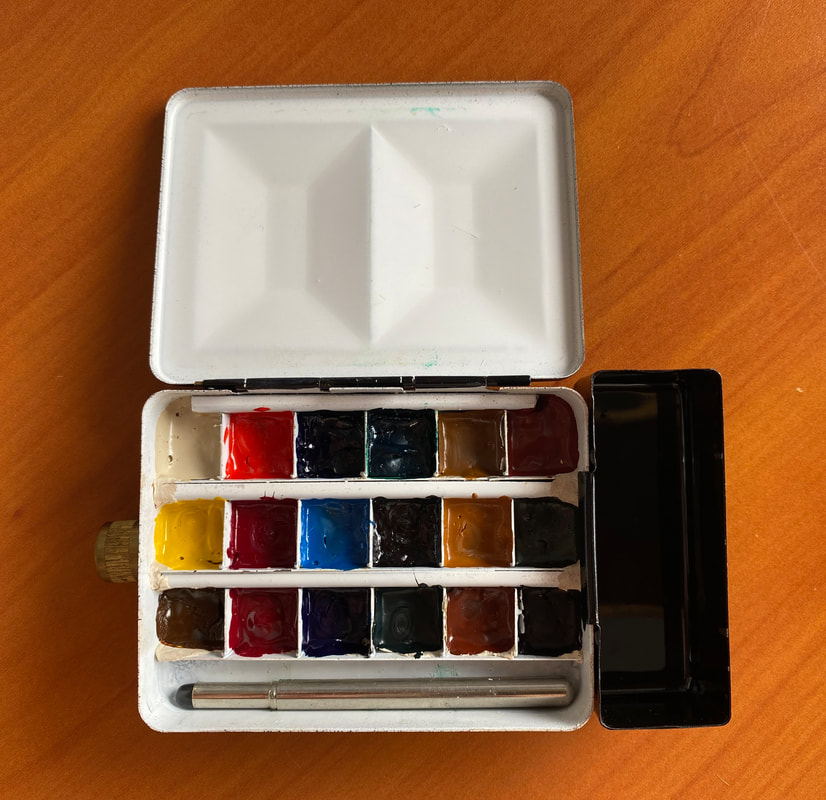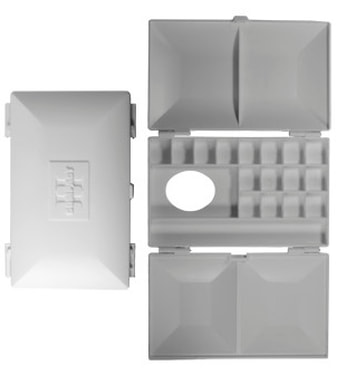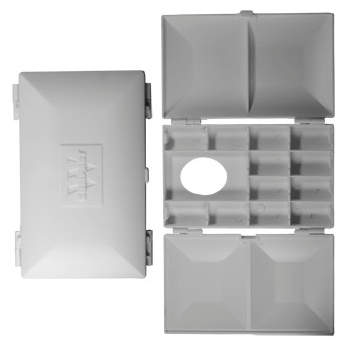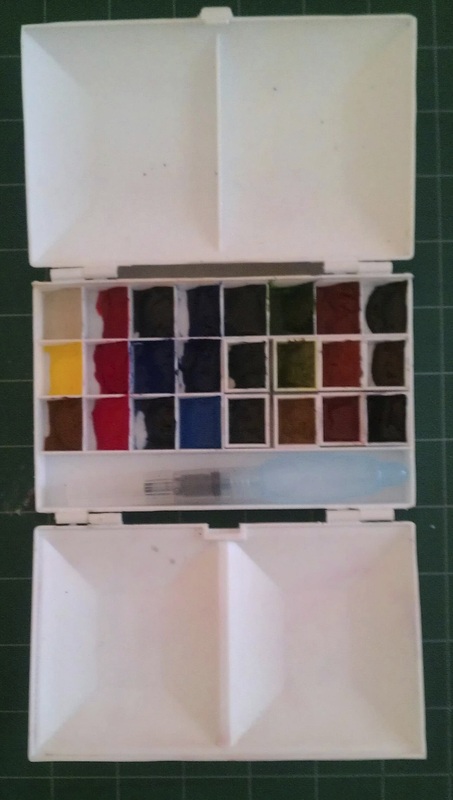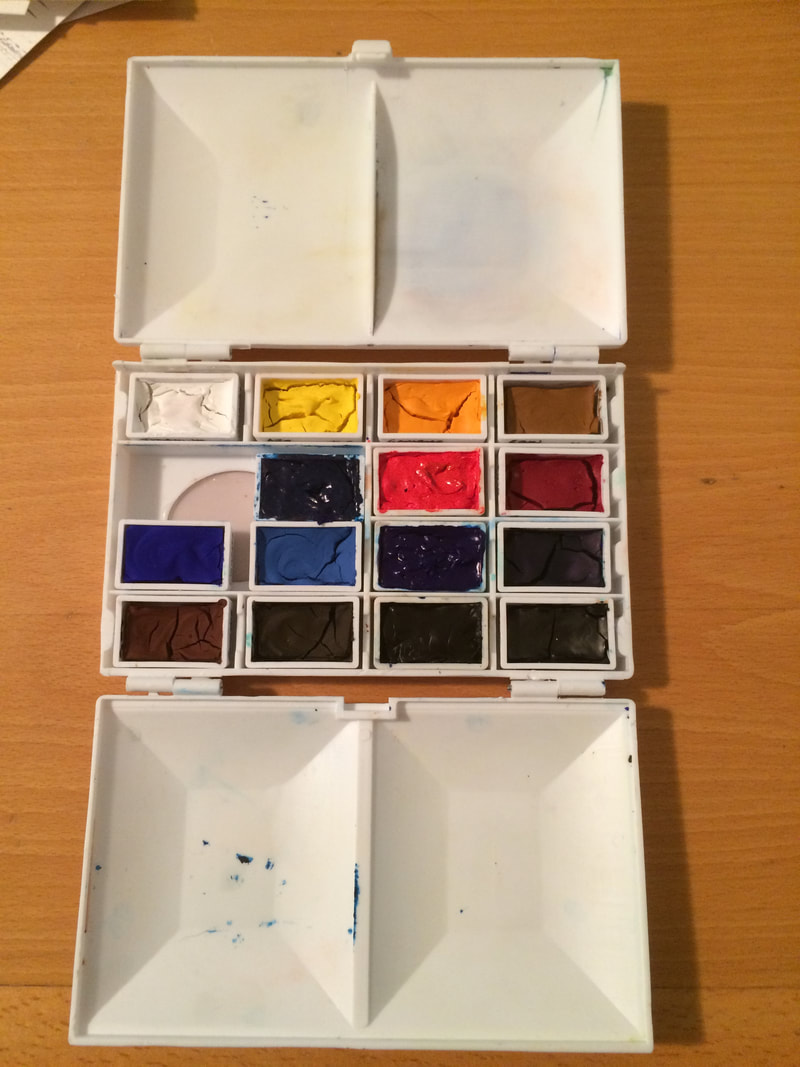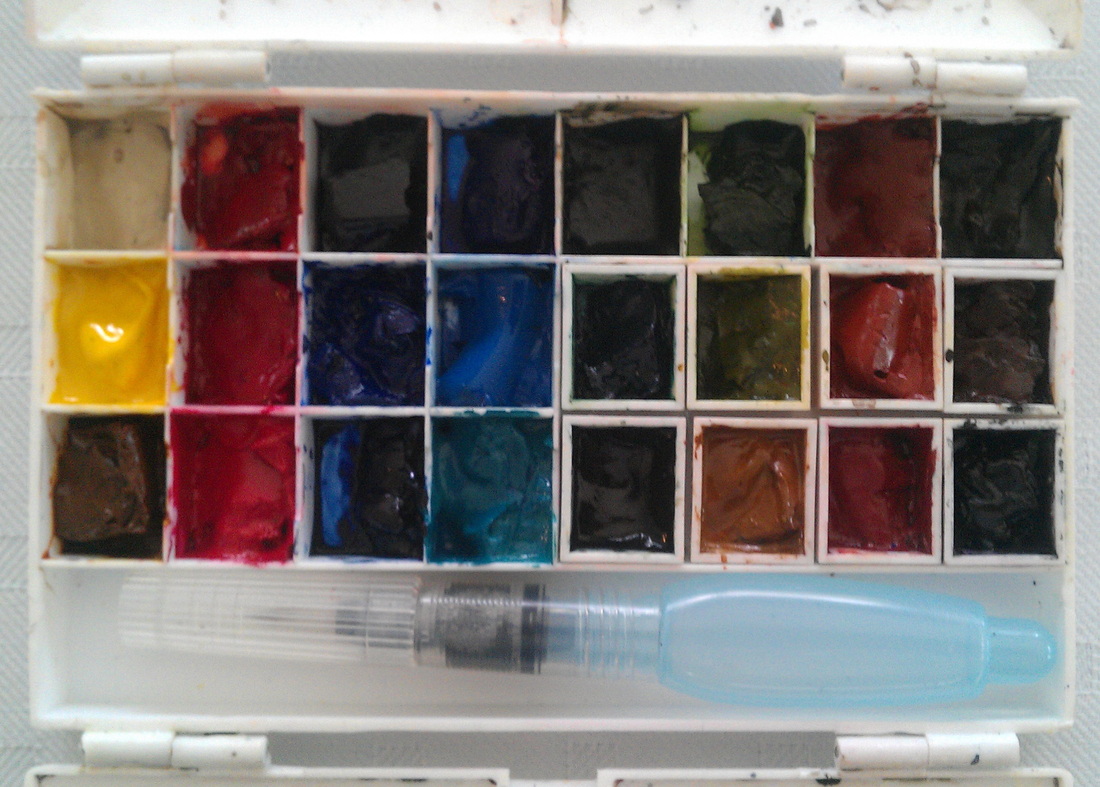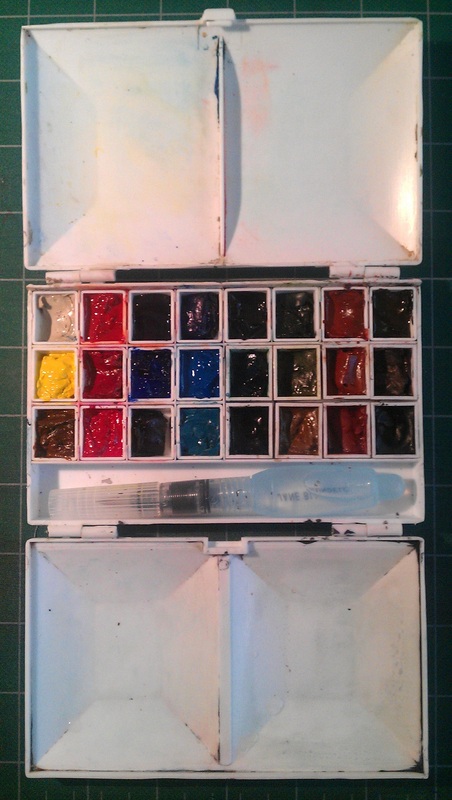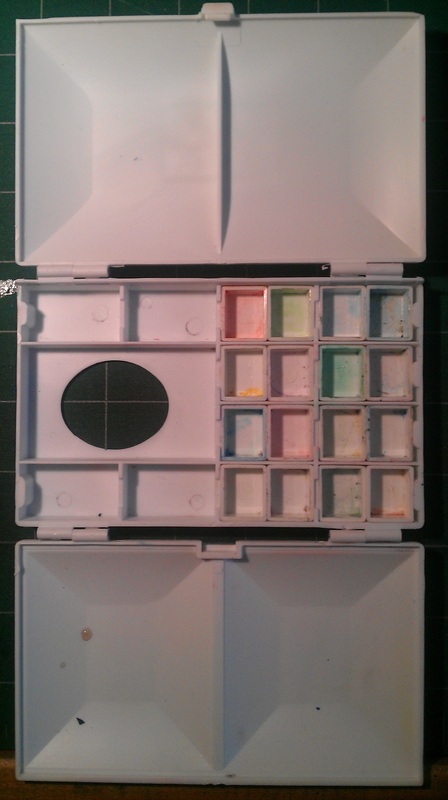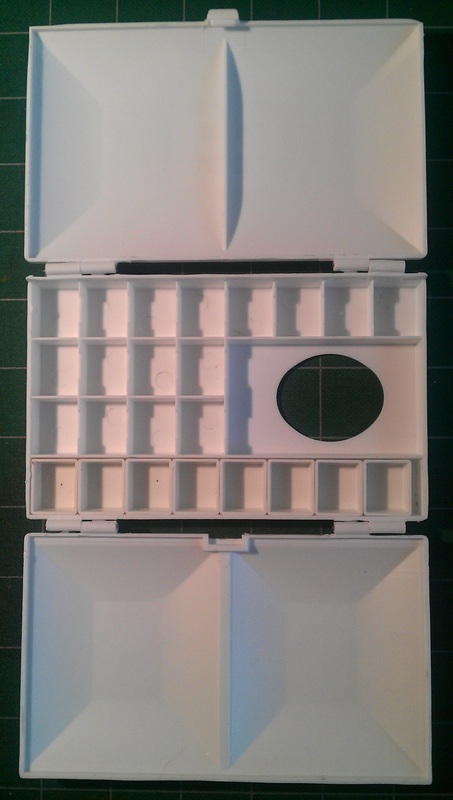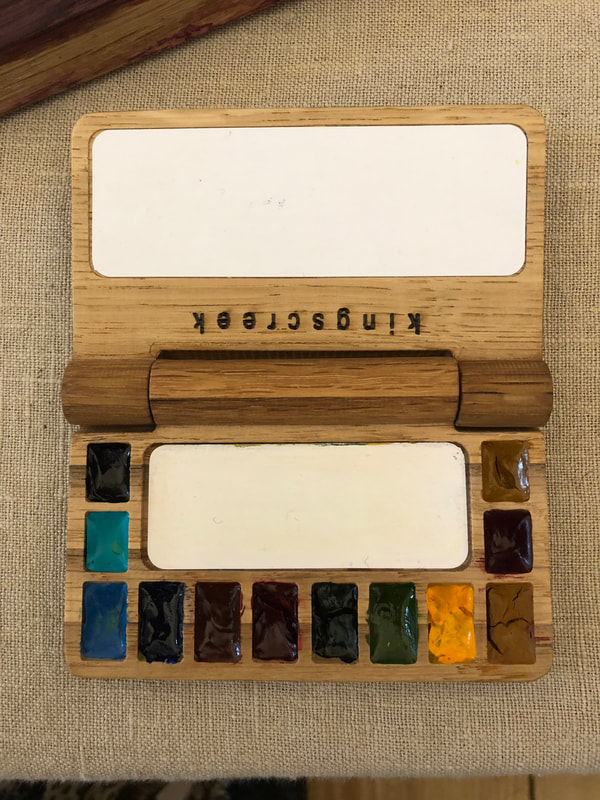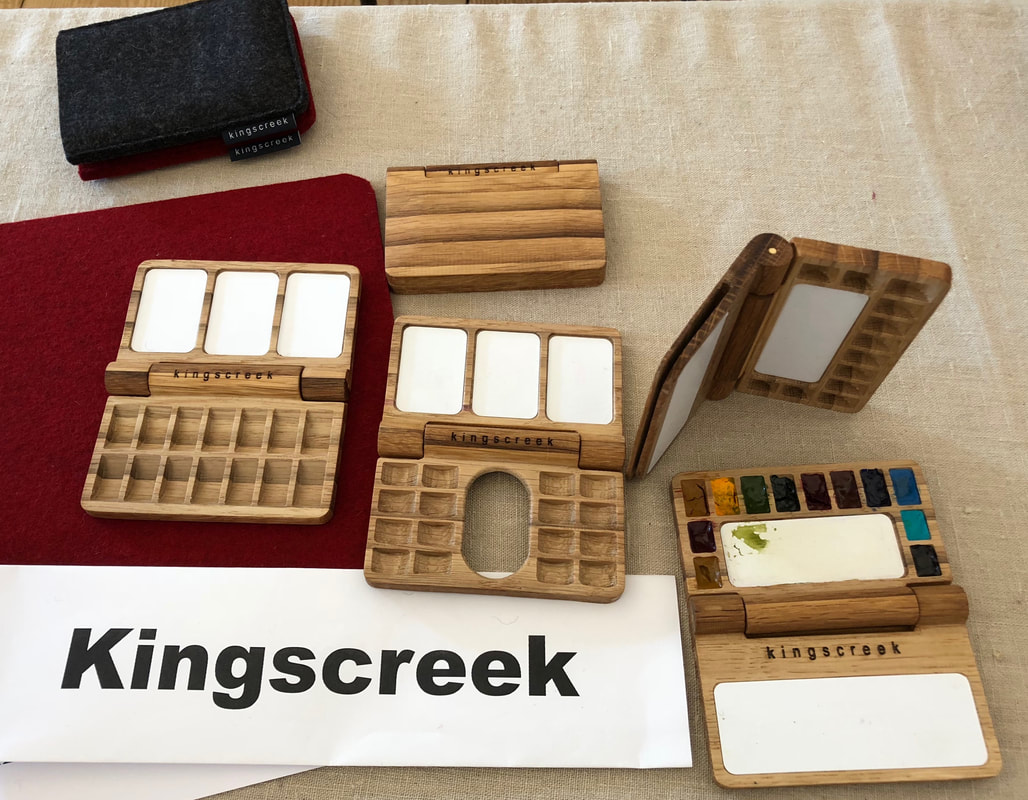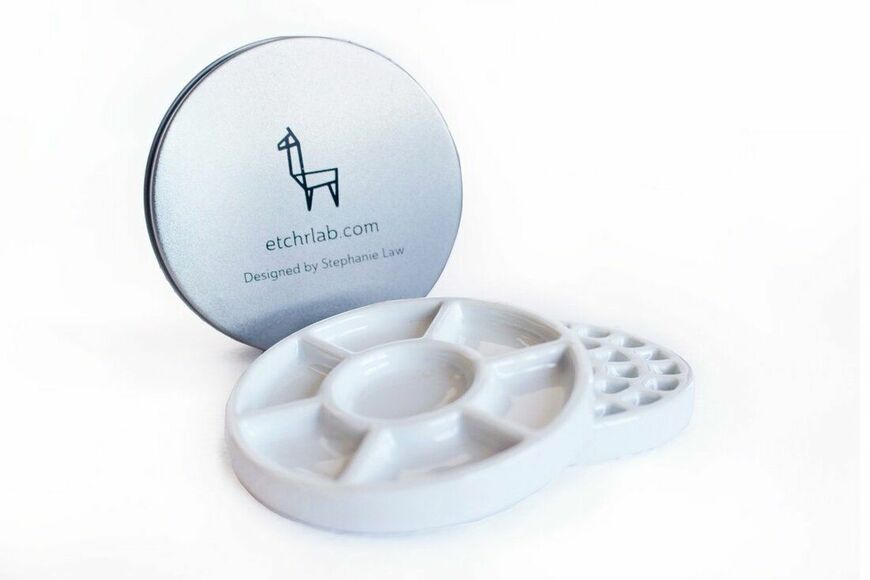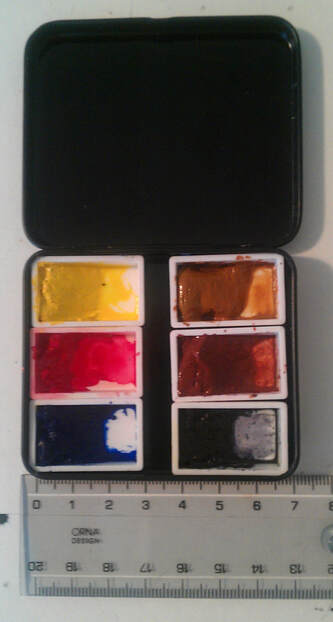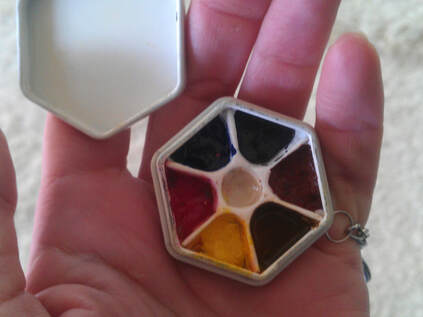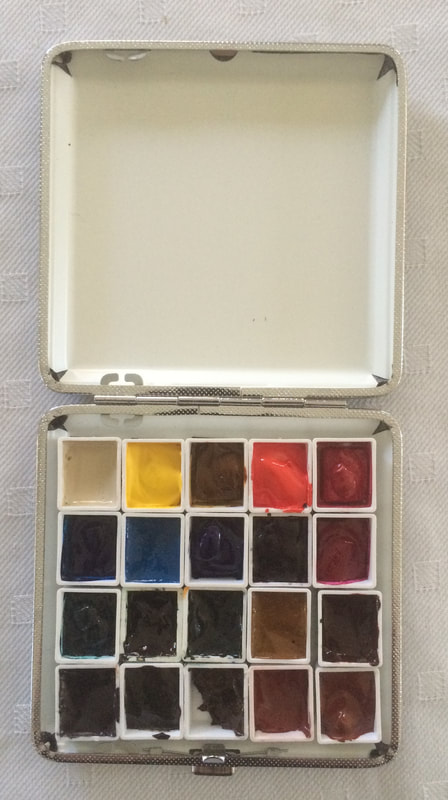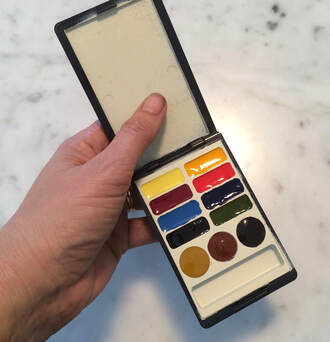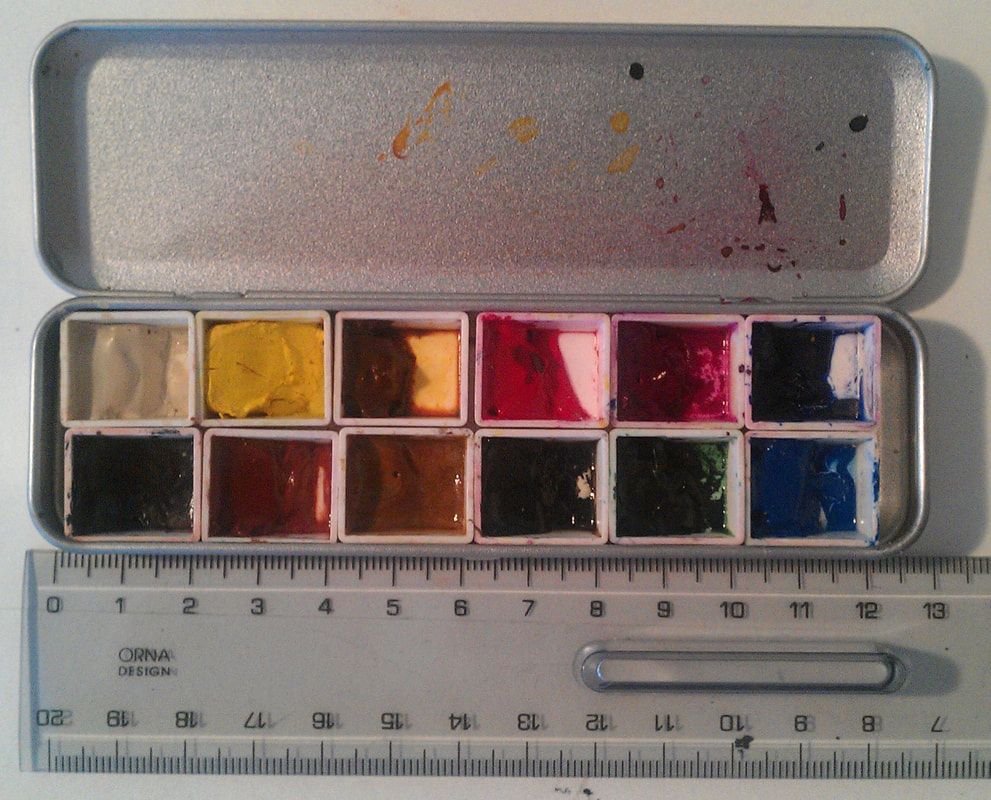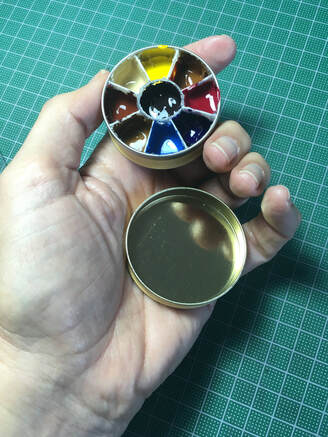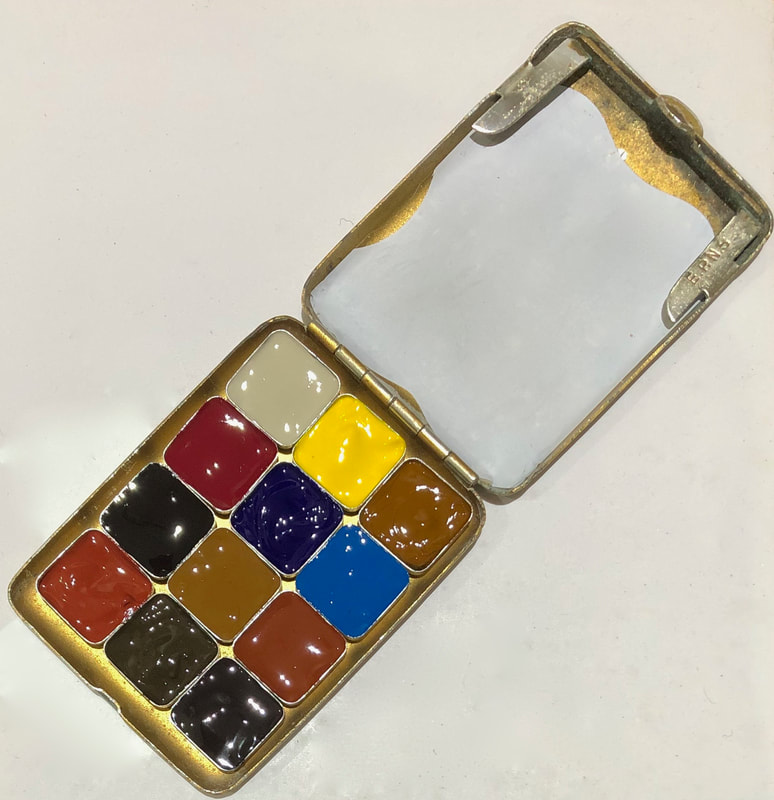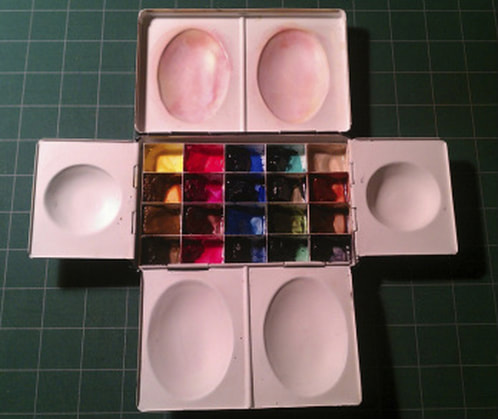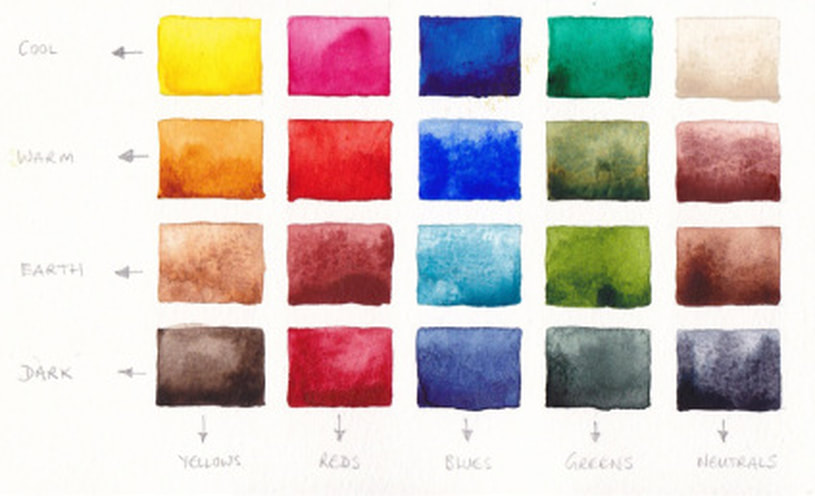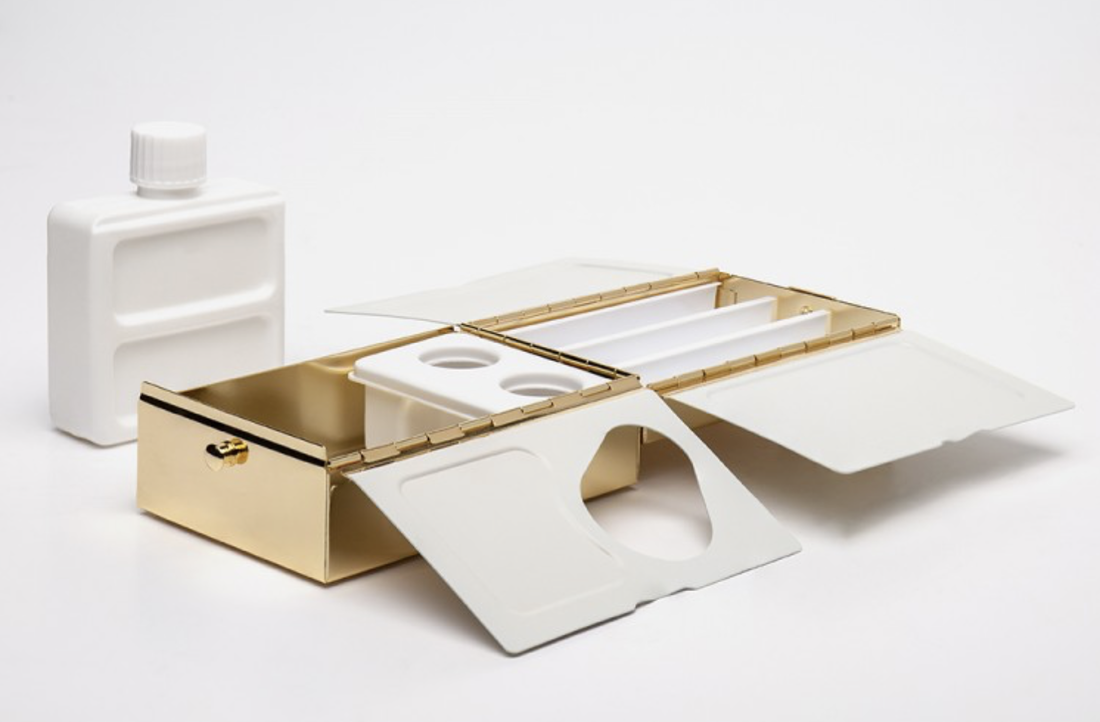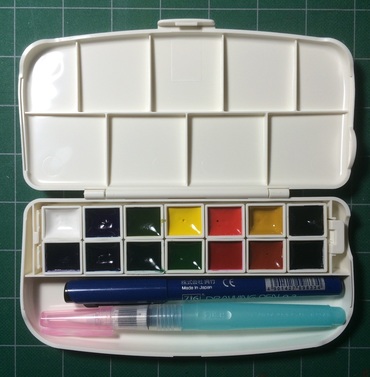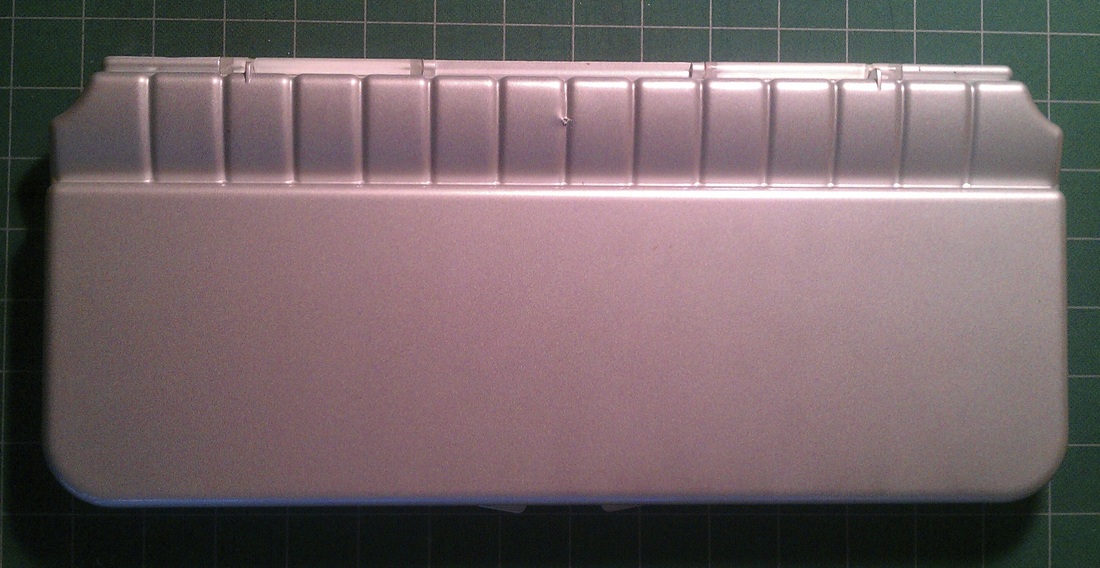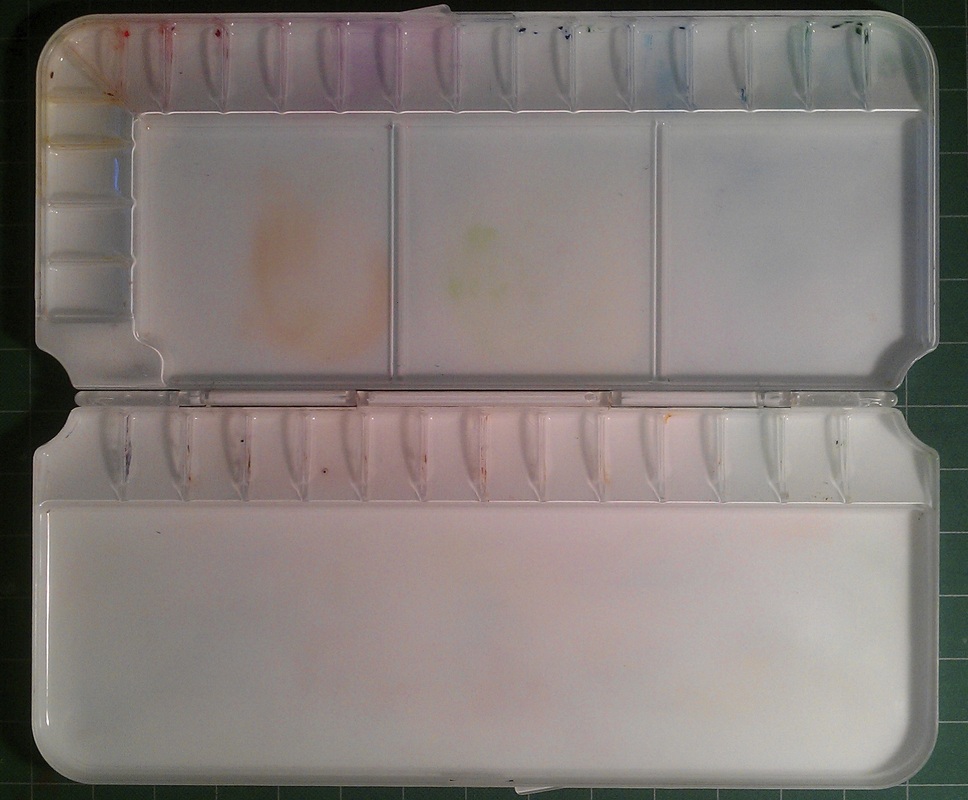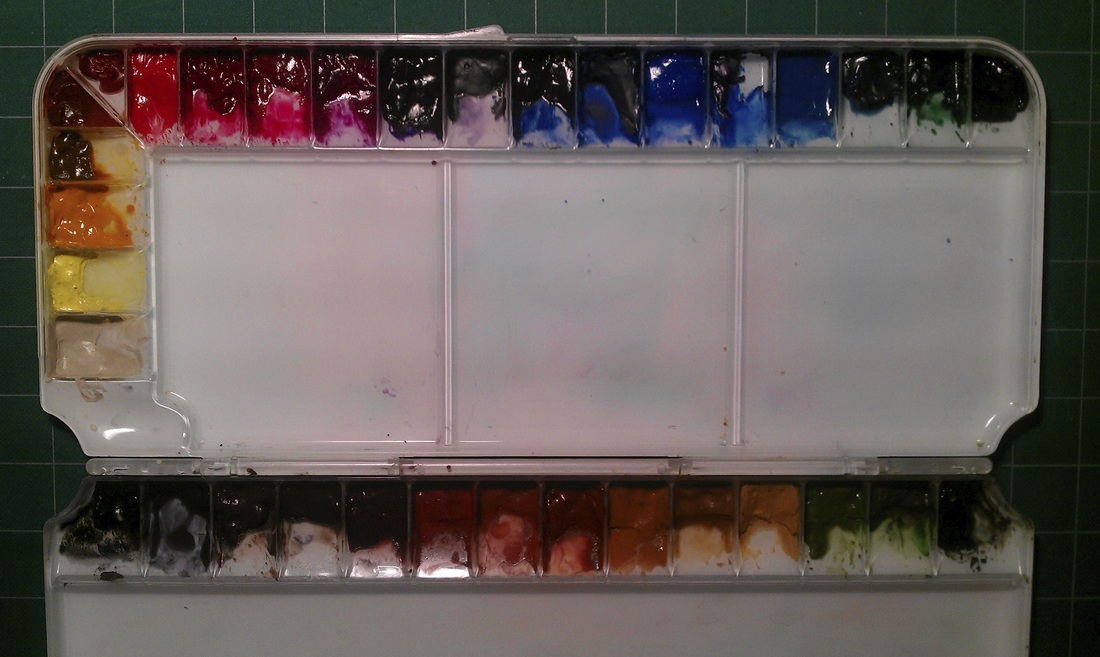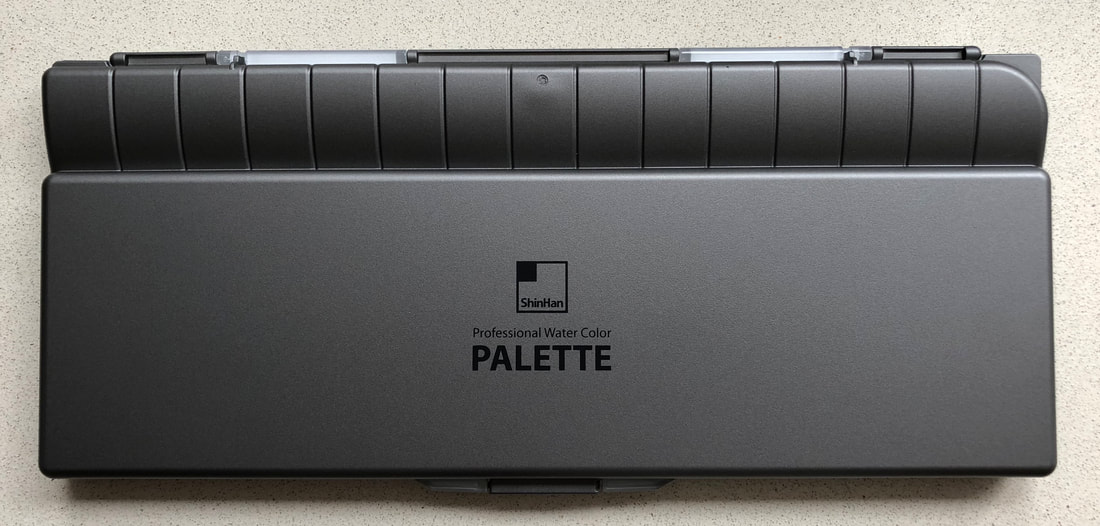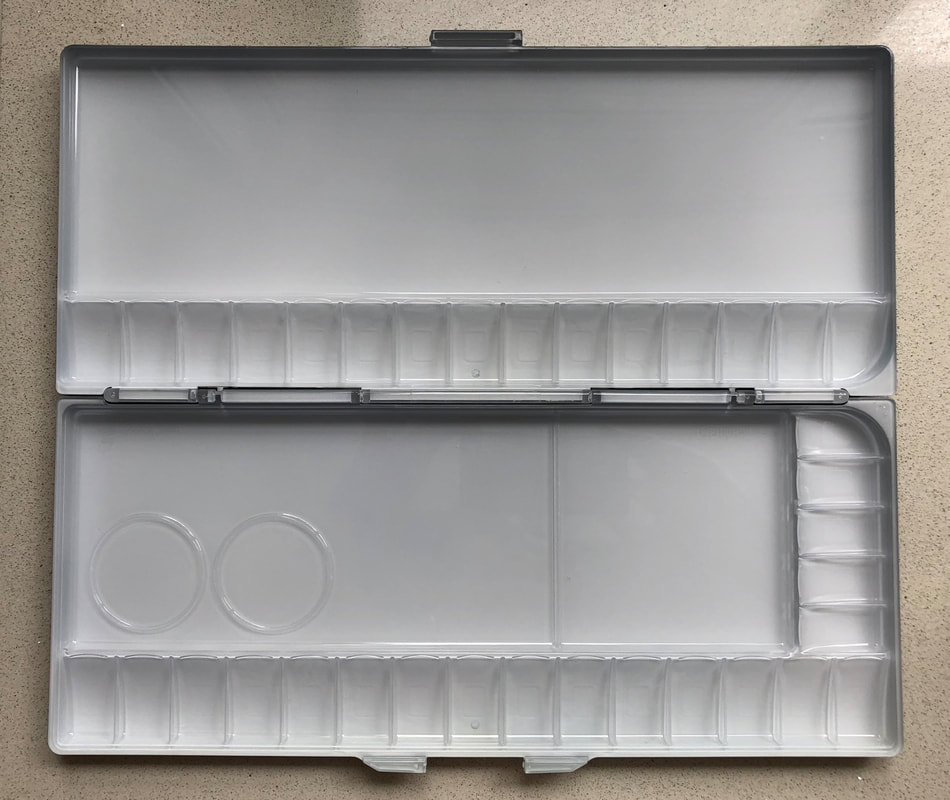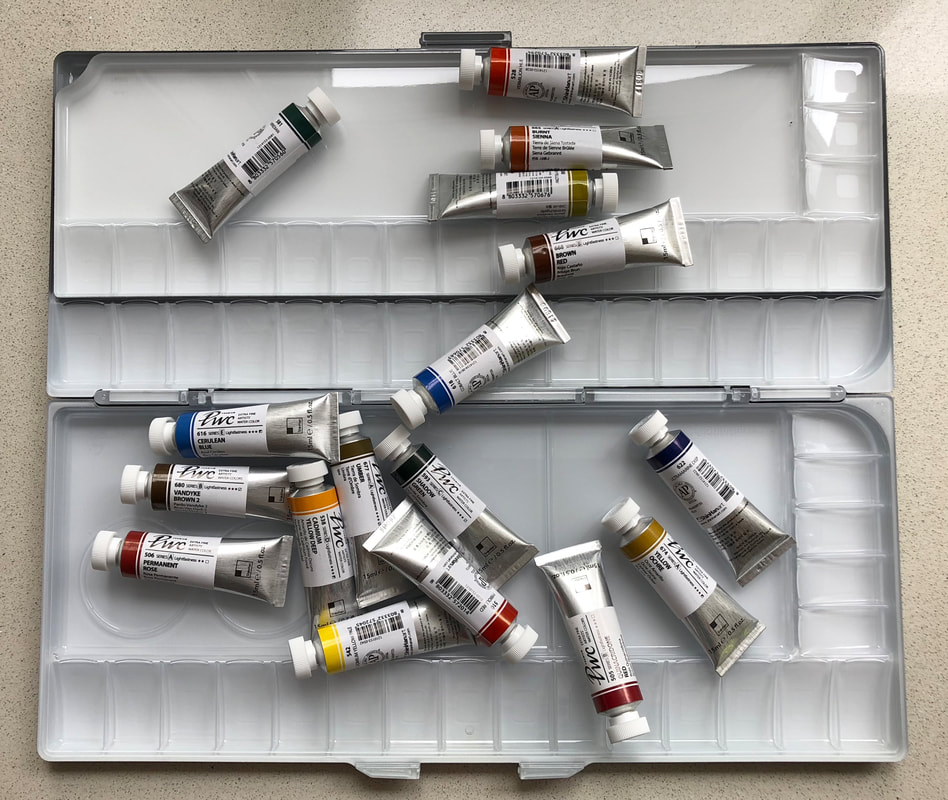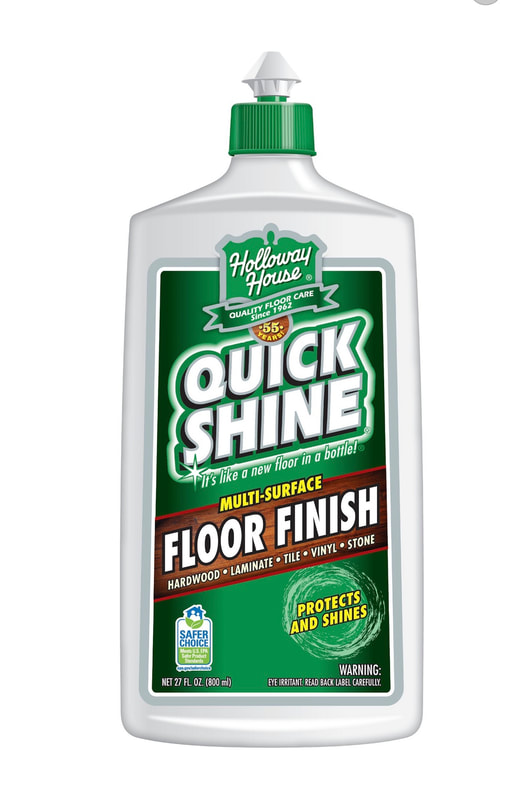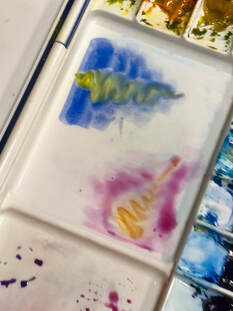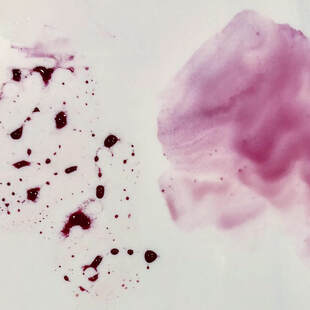Palettes
There are a huge number of palette options available. Some are designed as watercolour palettes, others can be adapted with some spray paint to work very well. Here are a few to look at.
I have written a couple of blog posts about filling palettes and pans and about the advantages of only partially filling them rather than completely filling them here.
(Note - I will be adding more information on Brushes too over time. See my Blog post here. See also information on travel brushes in the Plein Air Sketches tab above, and a Blog post here)
I have written a couple of blog posts about filling palettes and pans and about the advantages of only partially filling them rather than completely filling them here.
(Note - I will be adding more information on Brushes too over time. See my Blog post here. See also information on travel brushes in the Plein Air Sketches tab above, and a Blog post here)
Masters Folding palettes
The Masters Folding Palette is the palette I generally suggest my students use to start their watercolour journey. They are a very practical and economical choice. They can hold 20 or 28 colours directly in the colour wells and cost around $10 or less. There are many copies of the original version of this palette and the quality of the plastic does vary.
20 colour Masters palette
|
I make up the 20 colour Masters palette filled with Artist quality Daniel Smith and Da Vinci watercolours for my students.
This palette has my suggested 15 Ultimate Mixing Set colours with 5 useful extras. It is a fantastic range as it has three reds, two yellows and three blues to really increase choices in terms of mixing secondaries. It also has a wonderful range of earth colours and some great greens. It is largely single pigment colours with some convenience colours made out of other pigments in the palette. These are Undersea Green, Sap Green and Jane's Grey. It also contains a mix of transparent, staining, opaque and granulating colours. Suitable for the beginner or experienced painter, and small enough for travel and plein air painting. I make up these palettes for AU$125 (+GST) for shipping within Australia ($9.00 by courier) which is about the cheapest possible set up cost for a carefully chosen 20-colour Artist Quality watercolour palette. |
Here is a video showing the method I use to set up watercolour palettes.
|
28 colour Masters palette
|
I fill the larger 28 colour palette with almost exactly the same 20 colours as above, along with 2 oranges (bright and burnt), 2 purples (bright and neutral), another green and a granulating turquoise added, as well as an extra yellow and an extra earth yellow colour so it includes all three of my favourites - Yellow Ochre, Raw Sienna and the granulating Goethite. It is filled with artist quality watercolours as in the paint-out below. I don't totally fill the wells so there is a bit of space to make a wash of pure colour directly in the well if needed. I also label the colours with a waterproof pen, as you can see below . These paint wells are about 2.1x3.4mm. |
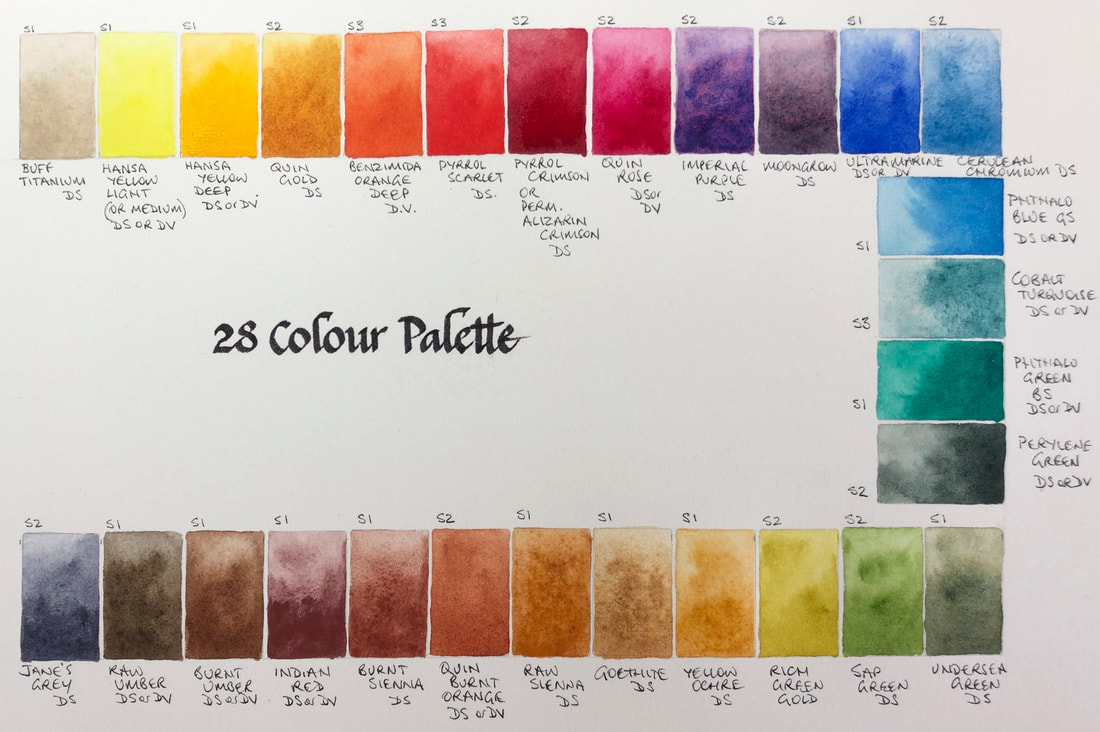
Masters 28 colour palette filled with a wonderful selection of artist quality paints. The cool yellow - Hansa Yellow Light - could be replaced with Hansa Yellow Medium which I love as a mid or primary yellow.
Quin Burnt Orange could be replaced with DS Transparent Red Oxide if a more granulating option is desired.
The one downside of any folding palette like these - with colours on both sides of the hinge - is that you have to allow them to dry before closing them to avoid colours running all over the place. Otherwise though they are a terrific palette and I have used them for years and set up hundreds for my students. This palette can be made up for $190 (+GST) and sent by courier within Australia for $9.00. The well size is larger than the 20-colour palette shown previously so you get more of each colour.
Mijello folding palettes.
Mijello, from Korea, have produced some really interesting and innovative palettes.
18 colour Mijello palette
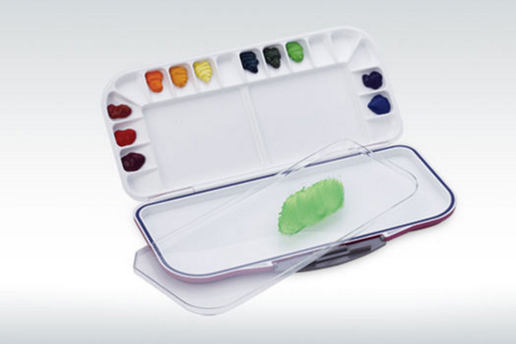 Mijello Fusion palette from the Mijello website http://www.mijelloart.com/fusion-18.html
Mijello Fusion palette from the Mijello website http://www.mijelloart.com/fusion-18.html
Another palette to look out for is the Mijello Fusion palette, (affiliate link) available from Jacksons UK and elsewhere. It is a very well designed palette that holds 18 colours, with three large mixing areas. You can see more images on their website here.
While more expensive than the Masters palettes shown at the top of this page, it has the advantage of having all the colours on one side so it can be closed when wet. It is designed to keep the colours moist but that isn't a factor for me as I always allow my tube paint to fully dry so they don't develop mould. I also don't find the need to spray them with water before use as many recommend. Daniel Smith and Da Vinci both rewet beautifully at the touch of a brush.
I tend to favour 20-colour palettes, but have set up this palette with Buff Titanium, Hansa Yellow Medium (or choose H.Y.Light), Quinacridone Gold (or Hansa Yellow Deep), Pyrrol Scarlet (or Da Vinci Permanent Red), Pyrrol Crimson, Quinacridone Rose, Ultramarine, Cerulean Chromium, Phthalo Blue GS, Phthalo Green BS, Perylene Green, Yellow ochre, Goethite, Raw Sienna (or a convenience green), Burnt Sienna, Indian Red, Raw umber and Jane's Grey. If I were setting it up as a sketching palette I might switch the Phthalo green out for DS or DV Sap Green as Perylene green is also great for mixing. This is the perfect setup for either of my online courses. You can see it set up below.
While more expensive than the Masters palettes shown at the top of this page, it has the advantage of having all the colours on one side so it can be closed when wet. It is designed to keep the colours moist but that isn't a factor for me as I always allow my tube paint to fully dry so they don't develop mould. I also don't find the need to spray them with water before use as many recommend. Daniel Smith and Da Vinci both rewet beautifully at the touch of a brush.
I tend to favour 20-colour palettes, but have set up this palette with Buff Titanium, Hansa Yellow Medium (or choose H.Y.Light), Quinacridone Gold (or Hansa Yellow Deep), Pyrrol Scarlet (or Da Vinci Permanent Red), Pyrrol Crimson, Quinacridone Rose, Ultramarine, Cerulean Chromium, Phthalo Blue GS, Phthalo Green BS, Perylene Green, Yellow ochre, Goethite, Raw Sienna (or a convenience green), Burnt Sienna, Indian Red, Raw umber and Jane's Grey. If I were setting it up as a sketching palette I might switch the Phthalo green out for DS or DV Sap Green as Perylene green is also great for mixing. This is the perfect setup for either of my online courses. You can see it set up below.
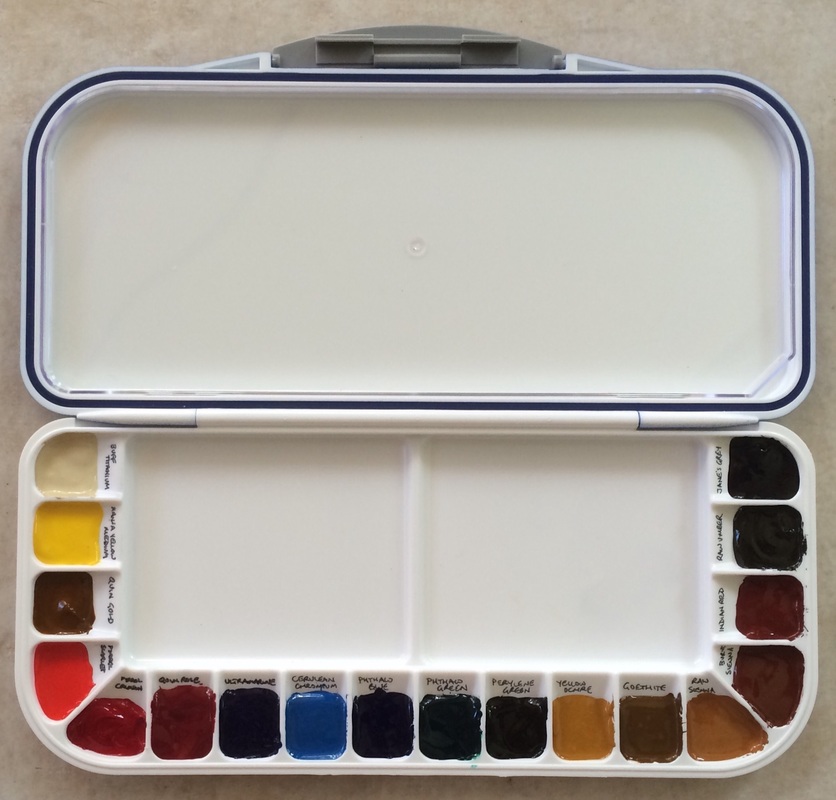
The 18 well Mijello Fusion palette filled with a palette of single pigment colours, plus Jane's Grey of course. My Ultimate mixing set or 15, along with Raw Sienna PBr7, Yellow Ochre PY43 and Perylene Green PBk31. This is a great range of mixable pigments, without the convenience Sap and Undersea greens I often like to add. I have written the colours in with permanent pen, but the wells can be filled fully if you know your colours.
Mijello 20-colour palette
The 20-colour version released in 2017 is my teaching palette - it has replaced the one above as I just like having 20 colours! Available from Jacksons in the UK - here is the affiliate link. It is large when opened - almost 12" square (just over 31cm wide and just under 29cm heigh) so not so useful for plein air, but it has huge mixing areas and, like the Fusion version above, includes a removable clear plastic mixing area that can be held over a painting to compare colours, or removed for cleaning.
I love this palette colour range. It has all my 'ultimate mixing set' colours and five extra colours - three greens and two more yellow earths. It is filled with Daniel Smith watercolours - buff titanium, hansa yellow medium, quinacridone gold, pyrrol scarlet, pyrrol crimson, quinacridone rose, ultramarine, cerulean chromium, phthalo blue GS, phthalo green BS, perylene green, undersea green, sap green, yellow ochre, goethite, raw sienna, burnt sienna, Indian red, raw umber and Jane's grey. All are single pigment colours except sap green, undersea green and Jane's grey. (Quinacridone gold is no longer available as a single pigment colour, but I stocked up ;-)
Width is about 310mm (12 3/8") and closed height is just over 150mm so this isn't a small palette. Great for studio work though.
The Fusion 24 palette is similar but has paints on both sides of the palette.
The Fusion 33 holds a lot of colours on one side of the palette.
There is also the massive Mijello Bulletproof palette - I've included the older 34 colour version lower on this section.
This is not the same palette of 20 that I use in the studio, but it's a range I'd highly recommend.
Width is about 310mm (12 3/8") and closed height is just over 150mm so this isn't a small palette. Great for studio work though.
The Fusion 24 palette is similar but has paints on both sides of the palette.
The Fusion 33 holds a lot of colours on one side of the palette.
There is also the massive Mijello Bulletproof palette - I've included the older 34 colour version lower on this section.
This is not the same palette of 20 that I use in the studio, but it's a range I'd highly recommend.
Mont Marte 'Airtight' Folding Palette
Substantially smaller than the 20-colour palette above, this is a great option for a plein air palette. It claims to be sealed so paints stay moist - not something I've ever wanted as I prefer to work with dried paint and reduce the chances of mould - but it's a great design if you want to get down to 16 colours with good brush access and plenty of mixing space. See more on my YouTube video here.
210mm wide and 105mm wide when closed. About 25mm deep when closed.
210mm wide and 105mm wide when closed. About 25mm deep when closed.
Metal Folding Palettes
Metal palettes are designed to hold half or full plastic pans. They are generally designed with an inner tray that grips the pans in place. They tend to be designed to hold 12, 24, 36 or even 48 colours.
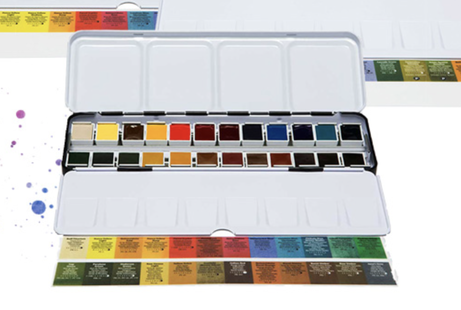 The New 24-colour half pan metal box by Daniel Smith.
The New 24-colour half pan metal box by Daniel Smith.
24-colour metal half pan set
In 2020 Daniel Smith released a 24-colour half pan petal palette and two 12-colour half pan metal palettes in this larger size. I suggested the colours for this 24-colour palette, so it has a wonderful range of colours, good for painting just about any subject you will come across - buff titanium, hansa yellow light, quinacridone gold, hansa yellow deep, pyrrol scarlet, permanent alizarin crimson, quinacridone rose, ultramarine, cerulean chromium, phthalo blue green shade, cobalt turquoise, phthalo green blue shade, sap green, perylene green, undersea green, raw sienna light, yellow ochre, goethite, Indian red, quinacridone burnt orange, burnt sienna, burnt umber, raw umber and Jane's grey.
It is a brilliant set to use for my Mastering Watercolours course :-)
You can see a paint-out of the whole set here.
In 2020 Daniel Smith released a 24-colour half pan petal palette and two 12-colour half pan metal palettes in this larger size. I suggested the colours for this 24-colour palette, so it has a wonderful range of colours, good for painting just about any subject you will come across - buff titanium, hansa yellow light, quinacridone gold, hansa yellow deep, pyrrol scarlet, permanent alizarin crimson, quinacridone rose, ultramarine, cerulean chromium, phthalo blue green shade, cobalt turquoise, phthalo green blue shade, sap green, perylene green, undersea green, raw sienna light, yellow ochre, goethite, Indian red, quinacridone burnt orange, burnt sienna, burnt umber, raw umber and Jane's grey.
It is a brilliant set to use for my Mastering Watercolours course :-)
You can see a paint-out of the whole set here.
|
12 colour palette metal folding palettes
The Art Basics metal travel palette is approx AU$30. There are similar palettes by Schmincke and others available in various price ranges, full or empty. Designed to hold 12 half pans and a travel brush or pencil, they can have 14 squeezed in very easily, as you can see on the below. I set up this palette set up with 14 colours for my students who wish to go plein air painting.
|
You could set up the metal palette with 14 of the colours shown here. You can choose whether to include the cool dark brown Raw Umber, the granulating opaque Indian Red or my custom mixed Jane's Grey as your final colour. Or just remove the pyrrol crimson, which you can almost mix with the scarlet and rose, and have all the others. |
If you take out the tray and you can load it with 24 half pans as pictured below left, or have a mix of whole and half pans as you can see below right. Or you could set it up with 21 half pans and leave room for a travel brush. These palettes are very versatile. Stick pans in with blu-tac or with adhesive magnets.
Daniel Smith Ultimate Mixing Set half Pan Palette
In 2018, Daniel Smith released 6 new palettes with half pans of hand poured watercolours. One of them is my Ultimate Mixing Set, a fabulous range of colours to use in the convenience of a travel case. This is a very simple palette to get started in watercolour. The box contains a second empty palette so you can add any other colours you wish.
Once any colour runs out, you can refill it from tube colours, including the new Daniel Smith Jane's Grey. Or, from 2020, you can but open stock filled half pans.
Here is an affiliate link to order from Jacksons Art in the UK.
You can see me painting out this set on YouTube here.
Once any colour runs out, you can refill it from tube colours, including the new Daniel Smith Jane's Grey. Or, from 2020, you can but open stock filled half pans.
Here is an affiliate link to order from Jacksons Art in the UK.
You can see me painting out this set on YouTube here.
Schmincke porcelain insert metal palette
|
A limited edition of this palette is available from www.artscene.com.au
|
This terrific Schmincke palette was originally released as part of its 125th anniversary in 2017, along with a number of new colours shown on my blog, and was available with two different 12-colour sets.
It has been released again with the Academy range most recently. I think it would be amazing with this selection of 12 intermixable artist quality Horadam colours: Aureolin Hue, Quinacridone Gold Hue, Transparent Orange, Vermilion, Ruby Red Deep, Ruby Red, French Ultramarine, Cobalt Cerulean, Perylene Green, Yellow Ochre, Maroon Brown (which is a lovely granulating burnt Sienna colour) and Neutral Grey. The porcelain insert adds weight, but overcomes the common problem with metal palettes that there isn't quite enough mixing space for larger washes. I had a play with mixing these mostly single pigment colours together and there isn't much they can't do. |
12 full pan metal palettes
This is the Da Vinci 12-colour full pan palette. The Da Vinci pans are larger than the 'universal' full pans - this would hold 14 of those. You can see more about Da Vinci palettes here. Once again, the tray can be removed and you can create your own custom arrangement of colours.
|
24-colour full pans metal palette set.
New 2021: The Roman Szmal Aquarius range has added a limited edition set of 24 full pans to its range. This is a really convenient set to get if you want a larger metal palette and larger pans in a great range of colours, ready to go. It has a rainbow of colours with two yellows, three reds and three blues along with an orange, a purple, a turquoise, a grey, some very workable greens and a great range of earth colours. |
Cotman travel palettes
By using a craft knife and cutting out the plastic that held the pans in place, I created enough space for 21 half pans, with room for a mini waterbrush and a travel brush. The half pans are held in place with Blu-tac. You could use double sided tape but it is easier to wash out the palette (which is worth doing periodically) if you set it up with Blu-tac. I like this palette hack :-)
Pocket Palette
|
This little pocket palette, the size of a business card holder, is wonderfully compact with a good range of colours. It was designed by Maria of expeditionaryart.com to be very portable and light weight. It's not what you'd use for large paintings in a studio but great for travelling.
The original version was stainless steel. There is a white mixing surface that is robust enough to be cleaned many times, and a magnet holds the little pans in place.
|
I filled with them with 14 of my ultimate mixing set as pictured below. As there are 14 spaces and my full set includes 15 colours, I had to remove one, so I included the lovely dark Raw Umber and not Indian Red but you could request Indian Red instead if you prefer. Jane's Grey is a custom mix of Ultramarine and Burnt Sienna and is fabulously useful for plein air painting.
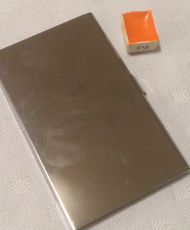 Size compared with a half pan. Size compared with a half pan.
Here is the closed palette, compared with a half pan of watercolour. It is designed around a credit card holder - remarkably small.
Below it is compared with the metal palette. |
New developments 2018
|
The next version of the Pocket Palette from March 2016 was created using even lighter aluminium that will not show fingerprints. The mixing area now has sides and the bottom lip has been reduced to allow better brush access.
|
In January 2018, half pans were added to the range and all the pans were redesigned with an anti rust treatment. I have used two of the half pans to be able to put all 15 of my Ultimate Mixing Set into the palette. Pictured are phthalo blue and phthalo green, as they are very powerful so may be used more slowly, but I think pyrrol scarlet and pyrrol crimson would be my preferred mini pan colours for urban sketching and travel sketching.
I sell these in Australia for AU$50 (+GST) empty or filled with my ultimate mixing set of artist quality paints AU$95 (+GST), plus shipping. |
|
New addition 2019
The previous 14 pan palette is now also available in black, and Maria has added the Demi Palette - just too cute for words :-) Here they are together. The Demi Palette is perfectly designed to hold 12 mini pans.
These little palettes are available in Australia from Seniors Art or Parkers, internationally from Jackson's Art, or buy directly from Expeditionaryart.com or from me for $40 (+GST) See more on my Blog about these here. |
New addition 2021
|
The latest addition to the Art Toolkit family is the Folio palette. This is in the same style as the original pocket palette and Demi Palette, but larger in size so the number of possible configurations is huge.
The size is 13.5 x 8.5cm, and this one comes with two large mixing pans that can be arranged as you wish. The challenge - and part of the fun - is deciding how to set it up for yourself. |
Portable Painter Palette
The Portable Painter was a clever plein air palette that was launched via Indiegogo in 2017. I like this design, even though originally limited to 12 colours, as it incorporates two water containers in a compact system. I always use two - one for clean and one for brush washing water, to keep my palette colours clean. I have written about it in detail here, including some great 12-colour palette suggestions. More of those can also be found in my website here. Available from Jacksons world wide - here it an affiliate link.
There is an expansion set of pans available for this palette, giving the option to add three to six more colours in the brush section. It is clearly shown on the website here.
There is an expansion set of pans available for this palette, giving the option to add three to six more colours in the brush section. It is clearly shown on the website here.
Portable Painter Micro
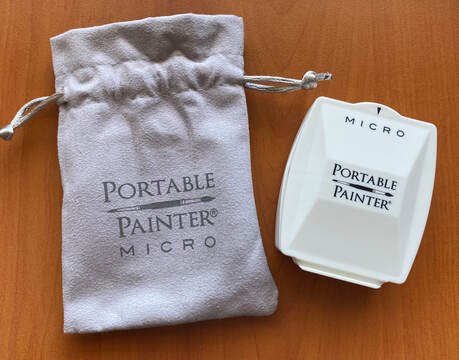
The new Micro palette has room for just 6 colours in custom made half pans, or change one or two of them to custom made full pans to have 4 or 5 colours. When this 'box' is opened, you have the option to attach the lid to one side of the enclosed palette as a mixing area, and the box to the other as a water container. As a general rule, the fewer colours you have, the more mixing space you need. This sturdy plastic design packs a lot of punch in the mixing space department with the four areas available. Here is the palette set up with space for 5 colours.
|
Here is is set up for 4 colours.
As the pans and half pans are removable, you can use this palette to explore a range of triad or limite palette options. I'd start with a basic primary triad of hansa yellow medium, quinacridone rose and ultramarine, then add either a contrasting triad or some convenient earth colours such as burnt sienna, yellow ochre or raw sienna and Jane's grey.
Here is a printout of a suggested 6-colour set. This gives a primary and a warm yellow for quick mixing, especially for wonderful greens; a primary rose red; a neutral earth orange; and two blues - a warm and a cool. The basic primary triad of Hansa Yellow Yellow, Quinacridone Rose and Ultramarine will create a huge range of colours; the warm yellow, cool blue and Burnt Sienna make mixing faster.
Of course there are many other sets of 6 that could be used. A warm red instead of Burnt Sienna would give a classic warm and cool primary set; the Quinacridone Gold could be switched to an earth yellow instead - Goethite, Yellow Ochre or Raw Sienna. A green could be added instead of the cool blue, and an orange and purple instead of the warm yellow and Burnt Sienna. The possibilities are endless.
You can see a number of 6-colour suggestions here. There are some expansions pans available for the Micro Portable Painter palette to increase the number of colours that can be included - to up to 16! Have a look here, where the many options are clearly shown. |
Tiny Italian Pocket Palette
|
This little Italian made chap was from Singapore arters.com.sg. Designed to hold 12 colours shown on the right, I have done a bit of sanding of the half pans to fit in 14 as seen below. You can see a paint-out of this palette here or read more about palettes on my Blog. The final photos show 15 half pans squeezed in by removing the tray - not an easy task - but now it holds my full 15-colour Ultimate Mixing set. There is now a 'naked' version available without the internal structures (shown on my blog post) so it is easier to personalise this little palette.
These palettes are made in Italy. There are three related companies - Fome Manufacturing, Farquar Manufacturing and Whiskey Painters Products. It is called the Whiskey palette due to the secret whiskey painters society who painted with whiskey as water was scarce. See more about these in a 2023 blog post here. Schmincke have a similar model with a water container and 8 colours. These are very small so are another option if you want to have your colours with you all the time, but a bit more mixing space than the credit card sized pocket palette pictured above. |
|
These photos are of a variation of the Scottie palette - this little cutie holds 18 colours in about ¼-pan size wells, with an integrated water bottle and an attachable water container. Shown closed and open.
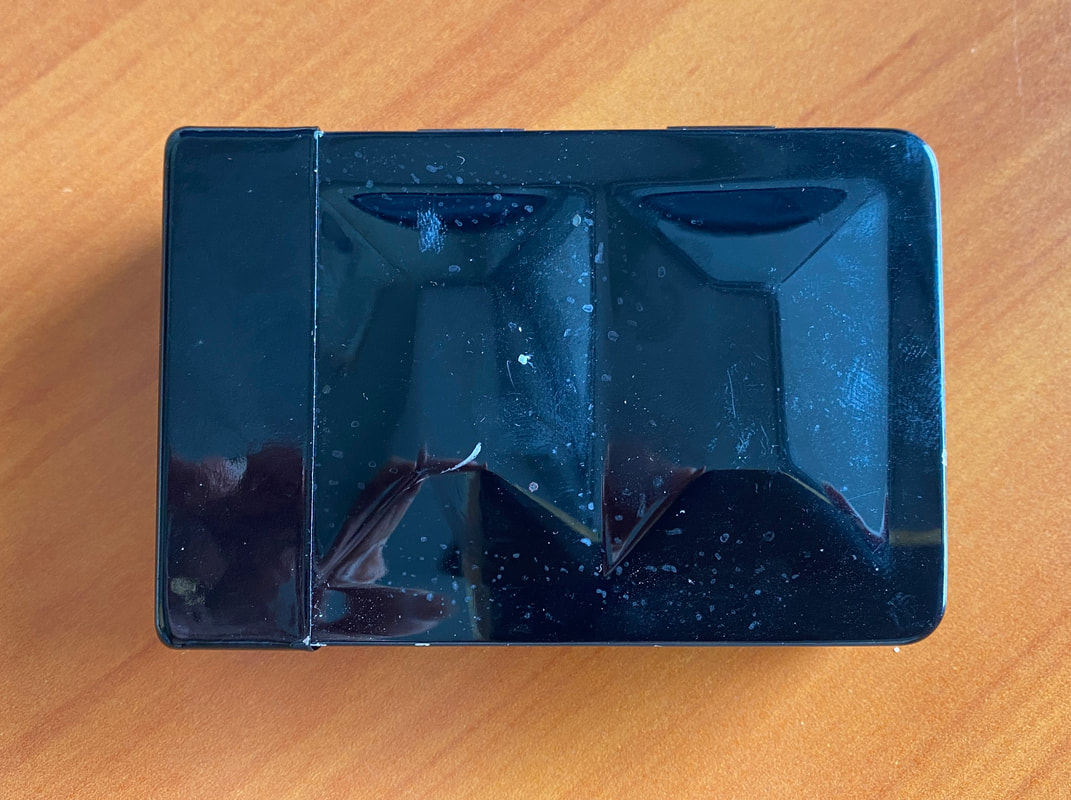
|
Herring Palettes
Another wonderful palette - one of my favourites - is the Herring compact palette (affiliate link) available from Jacksons Art in the UK. It is a bit more expensive than the Masters folding palette above but allows you to use either full or half pans of your colours. I have written a lot about these in my Blog here, and on YouTube https://youtu.be/QBsTC6_J_O0. And included my current set up here, with a paint-out.
It has nice deep mixing wells and is compact for travelling. You can buy empty pans and fill them yourself from your tubes or buy full or half pans of your chosen colours. If you fill in the thumb hole with some thin plastic or cardboard, you can stick in another 4 full pans or 8 half pans. The half pan model holds 16 colours with room for a brush and a sponge, or fill it with 32 half pans with the thumb hole covered and still have room for a brush. Fill the brush section with 8 more half pans and it holds 48 colours. Both models are very versatile and you can choose to put the paint directly into the wells rather than using pans if you prefer, as you can see below. I use the half pan model for my largest sketching palette (pictured right with the waterbrush), and I use the full pan model set up with 16 M.Graham and Schmincke gouaches as, unlike most gouache, these can be re-wet.
I have included a number of photos to show how much you can personalise or customise this palette. The first option is my general plein air sketching palette, and travels with me all over the world.
It has nice deep mixing wells and is compact for travelling. You can buy empty pans and fill them yourself from your tubes or buy full or half pans of your chosen colours. If you fill in the thumb hole with some thin plastic or cardboard, you can stick in another 4 full pans or 8 half pans. The half pan model holds 16 colours with room for a brush and a sponge, or fill it with 32 half pans with the thumb hole covered and still have room for a brush. Fill the brush section with 8 more half pans and it holds 48 colours. Both models are very versatile and you can choose to put the paint directly into the wells rather than using pans if you prefer, as you can see below. I use the half pan model for my largest sketching palette (pictured right with the waterbrush), and I use the full pan model set up with 16 M.Graham and Schmincke gouaches as, unlike most gouache, these can be re-wet.
I have included a number of photos to show how much you can personalise or customise this palette. The first option is my general plein air sketching palette, and travels with me all over the world.
|
|
|
Kingscreek palettes
|
While at the Urban sketchers Symposium in Porto in 2018, I visited a stand with these lovely wooden palettes. They are cleverly carved to slip onto the pages of your sketchbook. There are many more designs on the German website here.
I managed to resist buying one but thought I'd share them here. Available world wide from Kingscreek palettes. See the website for more innovative designs :-) |
Mini Palette from Etchr Lab
|
Just released in April 2019, this palette holds 37 colours in the specially designed ceramic palette. The palette and mixing wells fit into the tin. More on this can be found here. Once again, I haven't tried this palette but it's a great way to carry lots of colours!
Etchr Lab has also released a range of high quality cotton watercolour paper Sketchbooks and stock a number of carefully designed sketching bags. You can read more about these in the Sketchbook tab. |
And late in 2019, the 19-colour version was released. I've set that up with the warm colours in the top half and the cools in the bottom.
|
Home made palettes and more palette 'hacks'.
Watercolour is exceedingly portable and you can make a watercolour palette out of just about anything. You can make your own paint box by squeezing tube paints into an ice cube tray, sticking bought pans or home made pans onto almost any surface with blu-tac, magnetic strips or glue, or using a pill box which was designed to hold pills for a week or a month but is useful for holding paint! Dried cakes of colour can also be attached to a surface. You can use a china plate, plastic containers of almost any size or even a bit of cardboard to make a palette for your colours.
I have shown a silver cigarette case converted into a watercolour stick palette here and have converted a few small tins, a silver matchcase and cheap cigarette cases palettes. Be inventive and have some fun :-)
I have shown a silver cigarette case converted into a watercolour stick palette here and have converted a few small tins, a silver matchcase and cheap cigarette cases palettes. Be inventive and have some fun :-)
|
|
|
...Or you can have something professionally made out of brass or another metal.
Brass PalettesThere are a number of people making beautiful brass palettes. These are an expensive option but can be personalised to a large degree. You can see my travel versions in the Plein Air sketching tab here.
See palettes by John of Littlebrassbox here. This one pictured right is one of his Robertson style palettes - I use it exclusively in my studio. Have a look at David's amazing range from classicpaintboxes here. See my personal 20-colour palette colours painted out and explained, with the additional plein air 'extras' here.
|
The Frazer Palette
A new palette to the market in 2021 is the Frazer Price Brass Watercolour Box (affiliate link)
|
This is a remake of a brass palette that ceased production. It holds 18 colours, a water bottle, two (very small) water containers and some enamelled mixing areas. I haven't tried it but it looks like an interesting option for a plein air palette.
|
Student Palettes
|
You can buy a student quality watercolour palette and adapt it to your purposes by replacing the student watercolours with artist quality of your own choice. They are often quite compact and well designed, but the watercolours in them are usually frustrating - weaker and less lightfast than artist quality watercolours. They are often designed with a homogenous feel to them so you miss out on the range of characteristics that are possible with professional watercolours.
Here is a Kuretake student set. Once again the insides can be removed and replaced as the plastic palette is a very functional design. You can do the same with the Koi and other student sets, such as the W&N Cotman shown above. Creating your own personal palettes is rather fun.
|
Mijello 'Bulletproof' palette
|
This plastic palette made by Mijello holds 34 colours and claims to contain a plastic that is used to make bullet proof glass. It is a larger palette with an excellent mixing surface that cleans up very well.
It is a more expensive palette than the Masters, or even the Herring, and larger, so more suitable for the studio than plein air work. I used this very happily many years ago, but I replaced it with a brass palette that takes up less room on my drawing table. I enjoyed having all these granulating colours but opted to have them as 'extras' and use more traditional colours for my main studio palette. Note - it has been redesigned - the new version is here. Also see the Perfect Color palette and others in this well-designed range. |
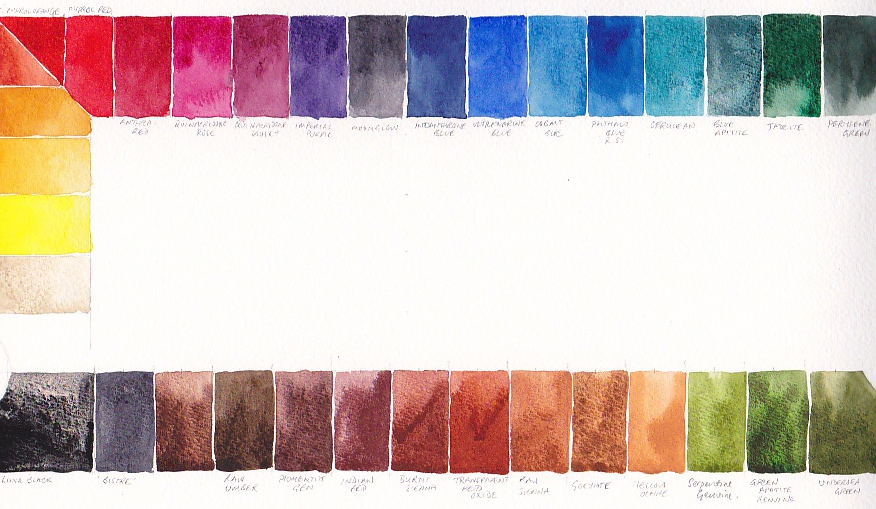
A paint-out of this massive 34 colour bullet-proof palette that I had set up with a number of favourites, including a huge range of granulating primatek colours. All Daniel Smith.
The colours are Buff Titanium, Hansa Yellow Medium (or Light), New Gamboge, Quinacridone Gold, Quinacridone Sienna, Transparent Pyrrol Orange, Pyrrol Red (not strictly necessary), Anthraquinoid Red (or Pyrrol Crimson), Quinacridone Rose, Quinacridone Violet (not necessary really), Imperial Purple, Moonglow, Indanthrone Blue, Ultramarine Blue, Cobalt Blue, Phthalo blue RS (or use Green Shade), Cerulean Chromium, Blue Apatite Genuine, Jadeite, Perylene Green, Undersea Green, Green Apatite Genuine, Serpentine Genuine, Yellow Ochre, Goethite, Raw Sienna, Transparent Red Oxide, Burnt Sienna, Indian Red, Piemontite Genuine, Raw Umber, Environmentally Friendly Brown Iron oxide (or use burnt umber), bistre (Jane's Grey) and Lunar Black.
As mentioned above, there are a number of excellent Mijello watercolour palettes. This design has been updated and Mijello now have their own range of watercolours, with palettes designed for their own sets as well as sold empty.
ShinHan Professional Watercolour Palette
This huge palette from Korea is even larger than the Bulletproof palette above. It is 36cm wide and just over 30cm (12") high when open. It has 35 generous paint wells and three large mixing areas. You then have the option to add an additional insert to hold 18 more colours. That's 53 colours! For those for whom too much paint is never enough, this may be the perfect answer, provided you have the space on your table. Made from polycarbonate (claims to be 30 times stronger than plastic) and designed to be stain free.
While I'd be reluctant to suggest anyone needs this many colours, having the option of removing a section is a great idea as the 'extra' colours could be put in this section to be used only when needed. I tend to put cadmiums in my 'extras' section, along with some of the Daniel Smith Primateks and some highly granulating colours that I use sometimes for special effects.
While I'd be reluctant to suggest anyone needs this many colours, having the option of removing a section is a great idea as the 'extra' colours could be put in this section to be used only when needed. I tend to put cadmiums in my 'extras' section, along with some of the Daniel Smith Primateks and some highly granulating colours that I use sometimes for special effects.
Cleaning your palette
Some watercolours stain your palette, whether it is made of plastic or enamelled brass. Phthalo colours are particularly staining but some are some of the reds. If you wipe out your palettes thoroughly with a cloth or paper towel with clean water, the stain that may remain won't affect future colours. However, if you wish to remove this staining, start by taking a paper towel and wiping the palette with a touch of vegetable oil. Phthalo colours are oil soluble so you will find that this will remove most of the phthalo staining. Then wipe with a clean paper towel thoroughly. Next use a bathroom cleaner - Jif, Gumption or whetever you have - and clean again. I like to use Masters Brush Cleaner and Preserver to clean palettes - it works very well. Once again wipe away all the residue.
To avoid beading, Amy suggests using Holloway House Quick Shine floor Finish! The images below show how this changes the surface tension so the paint doesn't bead up. I haven't tried it myself - I don't even know where it is available outside of the US - but I thought I'd pass that tip on.
To avoid beading, Amy suggests using Holloway House Quick Shine floor Finish! The images below show how this changes the surface tension so the paint doesn't bead up. I haven't tried it myself - I don't even know where it is available outside of the US - but I thought I'd pass that tip on.
Some artists never clean their palettes, enjoying having a ready supply of dried up mud colours available. I can't stand that! I keep my colours and palettes clean. I generally clean my palettes with just water after I finish each painting or sketch, and give it a thorough clean a few times a year to fully recover the white mixing surface.
Ceramic Palettes
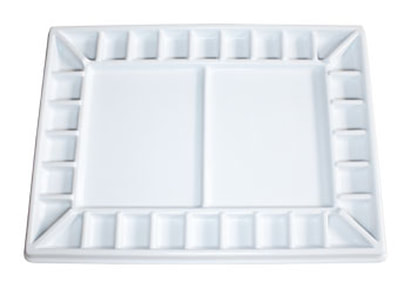 Academy 32 well ceramic palette from Jacksons, UK
Academy 32 well ceramic palette from Jacksons, UK
The only palette surface that simply doesn't stain is ceramic, which is one of the most beautiful surfaces to mix on. It wipes off with ease and doesn't stain. However ceramic palettes are heavy and fragile, and they take up a lot of desk or table space.
There are many fabulous ceramic palette designs, like this Academy 32-well model available from http://www.jacksonsart.com (affiliate link) but they are generally large, so they take up a lot of space, and relatively heavy so only suitable for home/studio use. I don't own large ones like this but I have a number of smaller ceramic mixing palettes that I use for inks and acrylic.
A white dinner plate, white ceramic soy sauce trays and other 'kitchen' ceramic options will also work. And there are flower shaped mixing palettes that are a joy to use.
There are many fabulous ceramic palette designs, like this Academy 32-well model available from http://www.jacksonsart.com (affiliate link) but they are generally large, so they take up a lot of space, and relatively heavy so only suitable for home/studio use. I don't own large ones like this but I have a number of smaller ceramic mixing palettes that I use for inks and acrylic.
A white dinner plate, white ceramic soy sauce trays and other 'kitchen' ceramic options will also work. And there are flower shaped mixing palettes that are a joy to use.
This page was last updated January 2024 © Jane Blundell
